

Essay on Vegetables
Students are often asked to write an essay on Vegetables in their schools and colleges. And if you’re also looking for the same, we have created 100-word, 250-word, and 500-word essays on the topic.
Let’s take a look…
100 Words Essay on Vegetables
Importance of vegetables.
Vegetables are vital for our health. They provide us with essential nutrients like vitamins, minerals and dietary fibre. Eating vegetables can help us maintain a healthy weight and protect us from diseases.
Varieties of Vegetables
There are many types of vegetables. Some grow above ground like tomatoes and lettuce, while others grow below like carrots and potatoes. Each vegetable has unique benefits and tastes.
Consuming Vegetables
We can eat vegetables in many ways. They can be eaten raw in salads, cooked in meals, or even juiced. It’s important to eat a variety of vegetables for a balanced diet.
Also check:
- 10 Lines on Vegetables
250 Words Essay on Vegetables
Introduction to vegetables.
Vegetables, the fundamental building blocks of our diets, are imbued with a rich assortment of nutrients that are essential for our well-being. They originate from various parts of plants including leaves, stems, roots, tubers, bulbs, and flowers, and exhibit a wide range of colors, textures, and flavors.
Nutritional Value of Vegetables
Vegetables are nutrient-dense foods, packed with vitamins, minerals, and dietary fiber, but low in calories. They supply us with a significant proportion of the daily recommended intake of essential nutrients like Vitamin A, C, K, and folate. Moreover, they are a rich source of phytochemicals, compounds that are proven to have numerous health benefits.
Health Benefits of Vegetables
Regular consumption of vegetables is linked to a reduced risk of many chronic diseases. They aid in maintaining healthy blood pressure, reducing the risk of heart disease, and preventing certain types of cancer. The fiber content aids in digestion, promotes satiety, and helps in weight management.
Vegetables and Sustainability
Vegetables also play a crucial role in sustainable agriculture. They can be grown in small spaces and in various climates, making them a versatile crop. Moreover, they can be integrated into crop rotations to improve soil health.
In conclusion, vegetables are not only a powerhouse of nutrients but also a key player in sustainable agriculture. Their diverse types offer a variety of tastes and textures, adding vibrancy to our diets. As we move towards a more health-conscious and sustainable world, the importance of vegetables in our diets cannot be underestimated.
500 Words Essay on Vegetables
The importance of vegetables.
Vegetables, the green, leafy, and colorful produce that adorn our plates, play a crucial role in our diets. They are the primary sources of essential vitamins, minerals, and dietary fiber, which are vital for the proper functioning of our bodies.
Vegetables are low in calories and fats but contain good amounts of vitamins and minerals. They are packed with vitamins A, K, B6, and C, and minerals like potassium, calcium, and iron. These nutrients help in maintaining optimal health. For instance, vitamin A is essential for good eyesight, while vitamin C boosts the immune system.
Vegetables and Disease Prevention
Several studies have shown a strong correlation between the consumption of vegetables and the prevention of chronic diseases. The high fiber content in vegetables helps in reducing the risk of heart disease and obesity. Additionally, the antioxidants present in vegetables, such as beta-carotene and vitamin C, can help protect against certain types of cancer.
Vegetables not only contribute to our health but also to the health of our planet. They require less water and land to grow compared to animal-based foods, making them a more sustainable choice. Moreover, the cultivation of vegetables contributes to soil health through crop rotation and diversification.
Variety and Cultural Significance
Vegetables offer a wide array of flavors, colors, and textures, contributing to diverse and enjoyable diets. They are a staple in many traditional dishes around the world, reflecting cultural diversity and heritage. From the humble potato in Ireland to the exotic bitter gourd in Asia, vegetables are deeply ingrained in our culinary traditions.
The Future of Vegetables
As we move towards a more health-conscious and environmentally sustainable future, the role of vegetables is set to become even more significant. Innovations in agriculture, such as vertical farming and hydroponics, promise to make vegetable farming more efficient and sustainable.
In conclusion, vegetables are integral to our health, culture, and the sustainability of our planet. As we continue to explore their potential, it is clear that these humble plants have much more to offer than meets the eye. Their importance in our diets and their potential role in shaping a sustainable future cannot be overstated. Therefore, it is imperative that we continue to promote vegetable consumption and explore innovative ways to grow them.
That’s it! I hope the essay helped you.
If you’re looking for more, here are essays on other interesting topics:
- Essay on Varanasi
- Essay on Uttarakhand
- Essay on Uttar Pradesh
Apart from these, you can look at all the essays by clicking here .
Happy studying!
Leave a Reply Cancel reply
Your email address will not be published. Required fields are marked *
Save my name, email, and website in this browser for the next time I comment.
- Skip to primary navigation
- Skip to main content
- Skip to primary sidebar
Student Essays
Essays-Paragraphs-Speeches
4 Essays on Vegetables & their Importance for our Health
Leave a Comment
Vegetables are an important part of our diet. They provide essential nutrients that keep us healthy and strong. Vegetables are low in calories and high in fiber, which makes them a perfect food for weight loss. They also contain antioxidants, vitamins, and minerals that protect us from disease.
List of Topics
Most vegetables are easy to prepare and can be eaten raw, cooked, or juiced. Vegetables can be added to soups, stews, salads, and stir-fries, or they can be enjoyed as a healthy snack.
There are many different types of vegetables, including leafy greens, root vegetables, cruciferous vegetables, and nightshades. Each type of vegetable has its own unique nutritional benefits. Leafy greens, such as spinach and kale, are packed with vitamins, minerals, and antioxidants. They are also a good source of fiber.
>>>> Read Also : ” Paragraph On Impacts of Junk Food”
Root vegetables, such as carrots and potatoes, are an excellent source of vitamins and minerals. They are also a good source of fiber. Cruciferous vegetables, such as broccoli and cauliflower, are a good source of fiber and antioxidants. They also contain compounds that help protect against cancer. Nightshades, such as tomatoes and bell peppers, are a good source of vitamins and minerals. They also contain antioxidants and anti-inflammatory compounds.
Vegetables are an important part of a healthy diet. They are low in calories and fat, and they are a good source of vitamins, minerals, and fiber. including leafy greens, root vegetables, cruciferous vegetables, and nightshades. Each type of vegetable has its own unique nutritional benefits.
Eating a diet rich in vegetables may help to protect against certain chronic diseases, such as heart disease, stroke, cancer, and type 2 diabetes.
Eating vegetables is a great way to improve your health. They are low in calories and high in fiber, vitamins, and minerals. Vegetables also contain antioxidants, which help protect against disease. A diet rich in vegetables may help to prevent chronic diseases and make us healthy and fit.
Importance of Vegetables:
Vegetables are an essential part of the human diet. They provide numerous health benefits and are packed with nutrients, vitamins, and minerals that our bodies need to function properly. Despite their importance, many people do not consume enough vegetables in their daily diet.
One of the main reasons for this is the misconception that vegetables are bland or unappetizing. However, with the right preparation and cooking methods, vegetables can be delicious and add flavor to any meal. Moreover, there is a wide variety of vegetables available that cater to different taste preferences.
Apart from being tasty, vegetables are also crucial for maintaining good health. They contain high levels of dietary fiber, which aids in digestion and helps to prevent constipation. Additionally, they are low in calories, making them an excellent choice for people looking to manage their weight or lose some pounds.
Vegetables are also rich in antioxidants, which help protect our bodies against diseases and infections. Antioxidants neutralize free radicals, which are harmful molecules that can damage cells and lead to chronic illnesses such as cancer and heart disease.
Another essential nutrient found in vegetables is Vitamin C. This vitamin is vital for strengthening the immune system and maintaining healthy bones, teeth, and blood vessels. It also acts as an antioxidant, protecting our cells from damage.
Moreover, vegetables contain a variety of minerals such as potassium, magnesium, and calcium, which are essential for various bodily functions. Potassium helps to regulate blood pressure while magnesium and calcium are crucial for strong bones and teeth.
Eating a diet rich in vegetables has also been linked to a lower risk of developing chronic diseases such as diabetes, obesity, and heart disease. This is because vegetables are low in saturated fats and cholesterol, making them heart-healthy foods.
In addition to the health benefits, consuming a variety of vegetables also adds color and diversity to our meals. Eating a rainbow of vegetables ensures that we are getting a wide range of nutrients and vitamins, which is essential for overall health and wellbeing.
>>>> Read Also : “A Paragraph on Flowers”
In conclusion, vegetables are a vital part of our diet and should be consumed regularly to reap their numerous health benefits. Whether cooked or eaten raw, incorporating a variety of vegetables into our meals can help us maintain good health and prevent chronic diseases
Short Essay on Vegetables:
Vegetables are an essential part of our diet, providing us with the necessary nutrients to keep us healthy and active. They are a rich source of vitamins, minerals, fiber and antioxidants that help in maintaining our overall well-being. From leafy greens to root vegetables, each type of vegetable offers unique health benefits.
One of the main advantages of including vegetables in our diet is their low calorie content. This makes them an ideal food choice for weight management and maintaining a healthy body weight. Vegetables are also packed with fiber, which promotes digestive health and helps in keeping us feeling full for longer periods of time.
Eating a variety of vegetables also ensures that we receive a wide range of nutrients essential for our body’s proper functioning. For example, dark leafy greens like spinach and kale are rich in iron, while brightly colored vegetables like bell peppers and carrots provide us with vitamin C and beta-carotene. Including a variety of vegetables in our diet helps in preventing nutrient deficiencies and reduces the risk of chronic diseases.
Apart from their nutritional benefits, vegetables also add flavor, texture, and color to our meals. They can be cooked in various ways – steamed, roasted, stir-fried or grilled – making them versatile and easy to incorporate into different dishes. They are also affordable and readily available throughout the year.
In addition to being nutritious and delicious, vegetables also have a positive impact on our environment. Growing vegetables requires less resources and produces fewer greenhouse gases compared to raising livestock for meat consumption. Therefore, by choosing to include more vegetables in our diet, we can contribute towards a more sustainable and eco-friendly world.
In conclusion, vegetables are an integral part of a healthy and balanced diet. They provide us with essential nutrients, aid in weight management, prevent diseases, add variety to our meals, and have a positive impact on the environment. It is important to include a variety of vegetables in our daily meals to reap their numerous health benefits and lead a healthier lifestyle
Essay on Vegetables for Class 1,2,3
Vegetables are a crucial part of our daily lives and they play a vital role in keeping us healthy. They provide us with essential nutrients, vitamins, and minerals that help our bodies function properly. In this essay, we will learn about the different types of vegetables and their importance in our diet.
Vegetables are classified into five main groups – dark green vegetables, starchy vegetables, red and orange vegetables, beans and peas, and other vegetables. Dark green vegetables include spinach, kale, and broccoli which are rich in iron, calcium, and vitamin C. Starchy vegetables like potatoes, corn, and peas are high in carbohydrates that give us energy to carry out our daily activities.
Red and orange vegetables such as carrots, sweet potatoes, and pumpkin are packed with beta carotene, which is converted into vitamin A in our bodies. This vitamin is essential for maintaining good eyesight and a healthy immune system. Beans and peas, like lentils, chickpeas, and kidney beans, are a great source of protein for vegetarians.
Other vegetables like onions, tomatoes, and bell peppers provide us with various vitamins and minerals that are essential for our overall health. They are also low in calories, making them a great addition to any weight-loss diet.
Vegetables not only provide us with important nutrients, but they also help prevent various diseases like heart disease, obesity, and certain types of cancer. They are an excellent source of fiber which aids in digestion and keeps our digestive system healthy.
In conclusion, vegetables are an important part of a balanced diet and should be included in our meals daily. Whether raw, steamed, or cooked, they provide us with numerous health benefits that cannot be ignored. So let’s make sure to eat our veggies and stay healthy! Remember, it’s never too early to start incorporating vegetables into our diets, so even young students can make a positive impact on their health by choosing to eat a variety of vegetables every day. So let’s all pledge to eat our veggies and be healthy!
Q: What is the importance of vegetables?
A: Vegetables are important because they provide essential nutrients, vitamins, and minerals for a healthy diet. They also add variety to meals and contribute to overall well-being.
Q: What is the short information about vegetables?
A: Vegetables are edible plants that provide a wide range of nutrients, including vitamins, minerals, and fiber. They are a crucial part of a balanced diet.
Q: What is a vegetable and its uses?
A: A vegetable is an edible plant or part of a plant. It is used for human consumption in various forms, such as salads, side dishes, soups, and as ingredients in a wide range of recipes.
Q: What are vegetables for Class 1?
A: For a Class 1 audience, you can explain that vegetables are healthy foods that grow in the ground and help make our bodies strong and fit. They come in many colors and shapes and can be delicious when prepared in different ways
Related Posts:

Reader Interactions
Leave a reply cancel reply.
Your email address will not be published. Required fields are marked *
Save my name, email, and website in this browser for the next time I comment.
- Privacy Policy

- Houseplants
- Gardening And Landscaping
Types of Vegetables: Different Kinds of Vegetables With Their Picture and Name
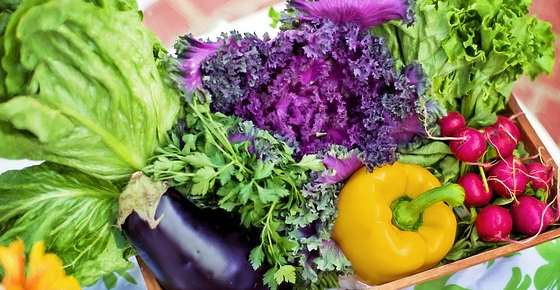
The are many types of vegetables that have different colors and flavors. The different types of vegetables are grouped together depending on which part of the plant is eaten. Of course, it is difficult to categorize each vegetable exactly. Some types of vegetables can fall into a number of categories when different parts of the plant are edible. For example, both the root and leaves of beetroot are edible.
This article has a list of different types of vegetables that we commonly eat. You will also find out about the nutritional values of these vegetable varieties.
Types of Root and Tuberous Vegetables (With Pictures and Names)
Root vegetables and tuberous vegetables are part of the staple diet of many people. Roots and tubers are generally vegetables that have carbs such as starches and sugars.
Let’s look at some of the most popular varieties of root vegetables, starting with types of tuberous vegetables.
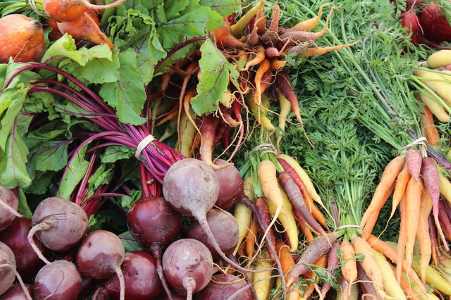
Types of vegetables: examples of roots and tubers

Potatoes ( Solanum tuberosum ) are a starchy root vegetable that are among the most popular varieties of vegetable.
There are numerous varieties of potatoes with Russet, Yukon Gold, and Marcy being popular varieties. Potatoes generally have a white to yellow flesh and brown skin. You can also buy purple potatoes.
You may be surprised to learn that potatoes contain valuable nutrients. For example, one large baked potato can contain nearly 40 mg of vitamin C, which is 64% of your daily needs. Eating the potato with its skin gives you 7 g of fiber which is nearly 30% of your fiber requirements. ( 1 )
The amount of carbs in one potato may not be as much as you expect. A 100 g serving of potatoes only contains 21 g of carbohydrates. This is about the same number of carbs as you would find in many types of beans.
Learn more about the different varieties of potatoes.
Sweet Potatoes are a type of tuberous vegetable

Sweet potatoes
Sweet potatoes ( Ipomoea batatas ) are an extremely nutritious root vegetable that is sweet and tasty.
Despite their name, sweet potatoes aren’t a true variety of potato. They usually have a long oval shape that tapers to a point. Their flesh is white to dark orange, depending on the type of sweet potato.
One of the reasons to eat sweet potatoes is that they are not a fattening food. A medium-sized sweet potato contains just 103 calories and nearly 4 g of fiber. Sweet potato also contains vitamins C, B6, and is one of the best dietary sources of vitamin A. ( 2 )
The most impressive nutritional factor of sweet potato is its high levels of beta-carotene. This important antioxidant is essential for good vision, brain function, and lowering your risk of chronic disease. ( 3 )
Another type of sweet potato are the purple varieties. Types of purple sweet potatoes contain powerful antioxidants called anthocyanins. ( 4 )
All varieties of sweet potato are very versatile. You can boil them, mash them, fry them, or bake them whole.

Beets (or, beetroot) is another example of a delicious root vegetable that is extremely good for you.
The most popular variety of beet is the classic dark-purple or red variety. However, you can also buy golden beets, pink beets, and even striped beets.
Beets are a very low-calories type of root vegetable. A 100 g serving of beets only contains 43 calories. Beets are also a type of sweet vegetable as they contain nearly 7% sugar and plenty of fiber. The root vegetable is also a good source of other nutrients, vitamins, and minerals. ( 5 )
Some studies indicate that juicing raw beetroot is a good way to help manage high blood pressure. This is because beets contain nitrate which helps improve blood flow. ( 37 )

Carrots are another sweet type of root vegetable, and although we mostly think of carrots as an orange root vegetable, they come in a wide range of colors. You can buy purple carrots, black ones, red varieties, and yellow carrots.
One thing in common with all types of carrots is that they are rich in antioxidants. The main antioxidant in carrots is beta-carotene which converts into vitamin A in your body. ( 6 )
All varieties of carrots are low in carbs and fat and high in vitamins, minerals, and fiber. Carrots have good amounts of vitamins A, C, K, and B-group vitamins. Because there are only 25 calories in a medium-sized carrot, they are a great vegetable to eat if you are trying to lose weight. ( 7 )
The best way to maximize the nutritional value of carrots is to cook them with a little olive oil. This helps your body absorb more of the nutrients, especially beta-carotene, to boost the antioxidant levels. ( 8 )
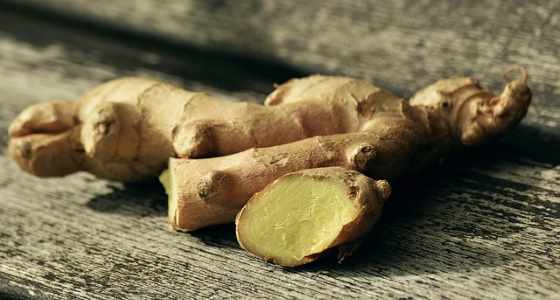
Ginger is a type of root vegetable that we often use as a spice or herb to flavor Asian meals.
Ginger is not as nutritious as the other root vegetables mentioned in this list. However, a 1-oz. piece of raw ginger contains trace amounts of most vitamins and minerals. ( 9 )
The main nutritious benefits of ginger come from medicinal compounds called gingerols and shogaols. These are powerful phytochemicals that have antioxidant, anti-nausea, and anti-inflammatory properties. ( 10 )
Other types of root and tuberous vegetables
Turnips are large round root vegetable that have a lot of vitamin C. Popular ways of eating turnip include mashed, boiled, or as a tasty ingredient in stews and soups.
Parsnips are a long white type of root vegetable that resemble the shape of carrots. Many people enjoy roasted parsnips where they take on a nutty flavor.
Jerusalem artichokes are edible tubers that have a sweet taste when cooked. However, they are not to be confused with “true” artichokes – a type of flower vegetable.
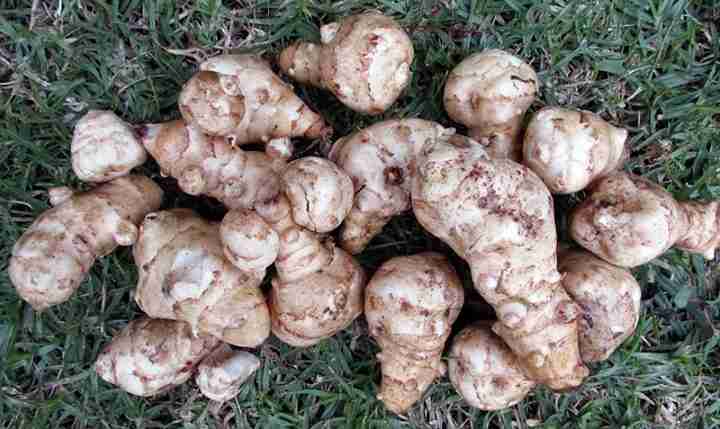
Jerusalem artichokes
Bulb and Stem Types of Vegetables
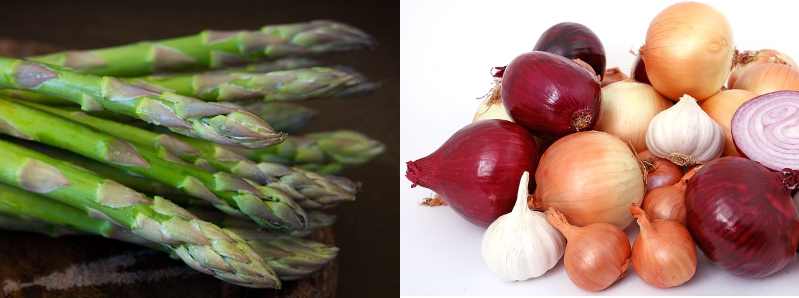
Types of vegetables: examples of bulb and stem vegetables
Let’s look in detail at other types of vegetables where the bulbs and stems are the edible part.

Garlic is one of the most popular varieties of bulb vegetables that is well-known for its pungent aroma and taste.
It is difficult to put garlic into a specific classification of vegetable. Some call it a root vegetable whereas others refer to it as an herb used in cooking.
Three cloves of garlic contain small amounts of protein, vitamins, and minerals and a tiny amount of fiber. ( 11 )
The most outstanding part of garlic’s nutritional profile is its medicinal compound called allicin. This sulfur-based chemical has anticancer and antimicrobial properties. Eating garlic may also help to lower blood pressure. ( 12 )
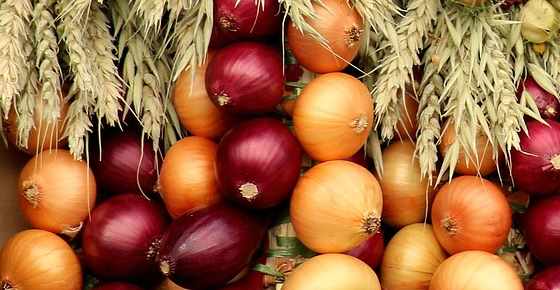
There are many varieties of onions , and you can use them as bulb vegetable to flavor food.
The different types of onions include yellow varieties, white onions, red onions, shallots, and scallions (sometimes called green onions or spring onions).
One medium-sized onion contains 44 calories per 100 grams. Onions also contain good amounts of vitamin C and B-group vitamins. The tubular leaves of green onions are also rich in vitamin K. ( 13 , 14 )
This type of vegetable contains a range of unique antioxidants called flavonoids. Studies have shown that these help to protect against a number of chronic diseases. ( 15 )

Asparagus is a type of green stem vegetable that many people call the tastiest vegetable on the planet.
The nutritional profile of asparagus is quite impressive, especially its levels of vitamin K. For example, 5 medium-sized asparagus stems contain 33 mcg of vitamin K, which is about 40% of your recommended daily intake (RDI). ( 16 )
This serving of 5 asparagus stems contains 16 calories and 1.7 grams of fiber. Asparagus is also low in carbs and contains moderate amounts of vitamins and minerals.

Celery is a low-calorie stem vegetable and is a great vegetable to snack on.
Nutritional data on celery shows that one large stalk or stem only contains 9 calories. This long stalk contains a gram of fiber, which is 4% of your RDI. Because celery is mostly water (95%), you can snack on this vegetable without worrying about putting on weight. ( 17 )
The mineral and vitamin profile of celery is also impressive. A large celery stalk contains 23% of your vitamin K RDI. You also get some vitamin A, C, folate, and vitamin B6. Celery also has trace amounts of most important vitamins.
Other varieties of bulbs and stem vegetables
Leeks are closely related to onions and could be classed as a bulb or stem vegetable. The sweet taste of chopped leek is a great addition to soups or stews.
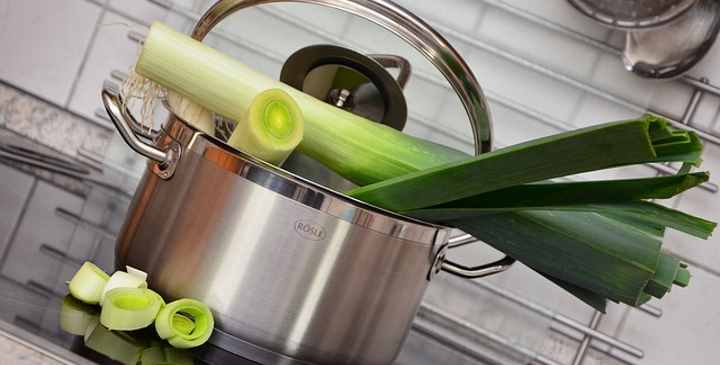
Fennel is a vegetable with a large oval bulb that has a taste similar to anise. Its bulb, stems, flowers, and seeds are all used as ingredients in meals.

Varieties of Leafy Vegetables
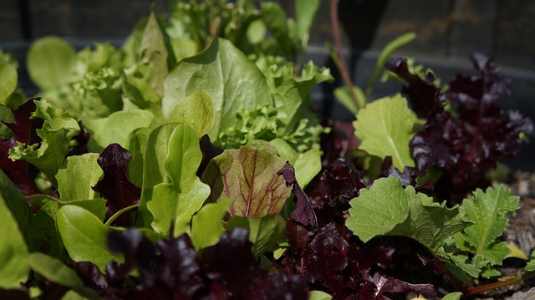
Types of vegetables: leafy vegetables
Leafy vegetables are an important source of nutrients. Many varieties of green leafy vegetables can be eaten raw in salads or boiled as an accompaniment to food.
Some root vegetables such as beets and dandelion produce edible green leaves that are also very nutritious.
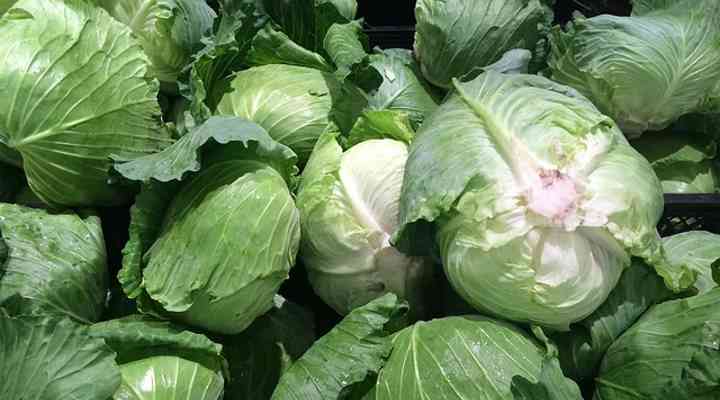
Cabbage is an example of a large leafy vegetable that can grow to the size of a soccer ball.
There are many types of cabbage that include green cabbage, red cabbage, and savoy cabbage.
Cabbage is also a type of cruciferous vegetable, and this family includes some types of leafy vegetables and flowering vegetables (i.e. broccoli and cauliflower).
A cup of chopped cabbage contains just 22 calories, 5 g of carbohydrates, and 2.2 g of fiber. This makes cabbage one of the top leafy vegetables when it comes to its fiber content.
Cabbage also contains an impressive amount of vitamin K with a massive 67 mcg (85% RDI) in a cup of chopped vegetable leaves. ( 18 )
Spinach is a type of green leafy vegetables

Spinach may be one of the healthiest varieties of leafy vegetables you can eat.
Spinach is a nutrient-dense vegetable that has many benefits. For example, just one cup of spinach contains 108% of your vitamin K RDI. Spinach is also rich in vitamin A, C, and folate. Spinach also contains moderate levels of all essential minerals. ( 19 )
Brussels sprouts
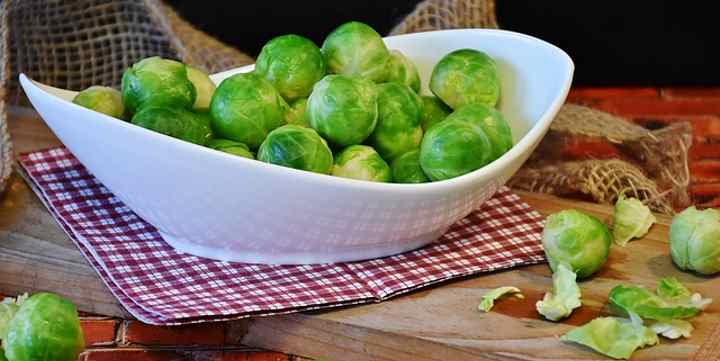
Brussels sprouts are another type of cruciferous vegetables that are grouped in the leafy vegetable variety.
These small leafy green vegetables are a storehouse of vitamins, minerals, and fiber. In fact, just a cup of Brussels sprouts contains 3.3 g of fiber which is 13% of your RDI. This serving of Brussels sprouts also contains 125% of your daily vitamin C requirements.
What’s more, these leafy vegetables contain good amounts of protein, vitamin A, E, and B-group vitamins. You also get plenty of calcium, iron, potassium, and manganese in Brussels sprouts. ( 20 )

There are many lettuce varieties that are perfect for creating delicious salads with.
Due to its high-water content and minimal number of calories, lettuce is a great food to eat if you are trying to lose weight. Lettuce leaves also make a great accompaniment in sandwiches or other types of meals.
A cup of shredded lettuce only contains 5.4 calories. However, you get 2,665 IU of vitamin A (53% RDI), 62.5 mcg of vitamin K (73% RDI), and 6.5 mg of vitamin C (11% RDI). Lettuce also contains potassium, magnesium, calcium, and iron. ( 21 )

Kale is on the list of green leafy vegetables that are also classed as a superfood.
The reason why leafy kale has become such a popular vegetable is due to its nutritional profile.
For example, a cup of chopped kale contains a whopping 547 mcg of vitamin K (684% RDI), 10,302 IU of vitamin A (206% RDI), 80.4 mg of vitamin C (134%), and 1.3 g of fiber (5%). This super nutrient-dense leafy vegetable only contains 33 calories. ( 22 )
Other types of leafy vegetables
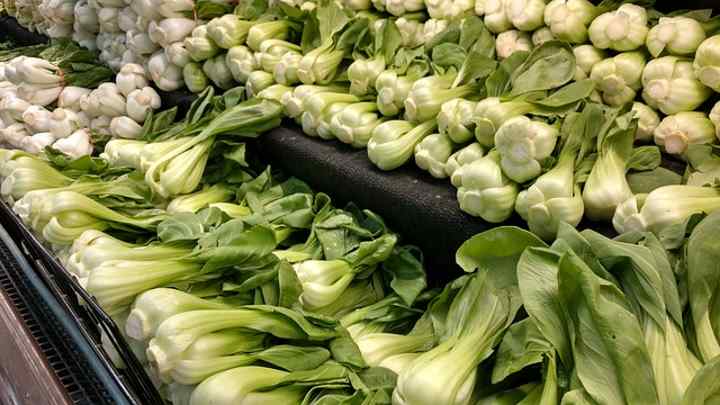
Swiss Chard

Types of Podded Vegetables
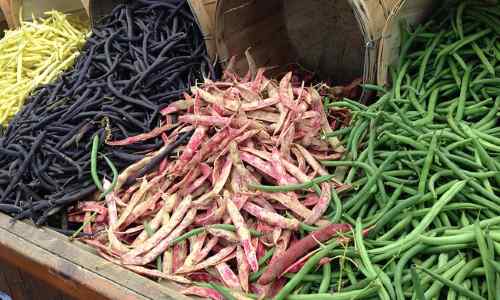
Types of vegetables: examples of podded vegetables
Podded vegetables (or, pod vegetables) include types of vegetables that contain seed, peas, or beans encased in a pod. Legume is a term for the seeds or fruit of podded vegetables.

Beans are an important type of vegetable seed because they are essential sources of plant-based protein.
There are a number of types of beans that are delicious to eat. Some of the most popular bean varieties include kidney beans, pinto beans, cannellini beans, soybean, chickpeas ( garbanzo beans ), and black beans.
A cup of cooked kidney beans contains an impressive 15 g of protein (31% RDI) and only 225 calories. ( 23 )
Beans are also an important source of minerals. A cup of beans contains iron (22% RDI), phosphorus (24% RDI), manganese (38% RDI), and potassium (20% RDI).

Peas are a delicious and nutritious type of vegetable seed that come packaged in a pod.
Some types of peas such as garden peas are consumed as seed vegetables without their pod. Other varieties of peas such as snow peas or sugar peas are generally eaten along with their pods.
When it comes to tiny healthy vegetables, peas are one of the top on the list. A 100 g serving of green peas gives you 5.7 g of fiber which is 22% of your RDI. However, there are just 84 calories in this serving of peas. ( 24 )
Peas, like beans and lentils, are also good sources of plant-based protein. One cup of peas contains 8.6 g of protein, which is 17% of your daily requirements.
Lentils are a type of legume that is also grouped together with podded vegetables.
Lentils come in a variety of colors such as red, black, and green. In many countries, lentils are one of the primary sources of non-meat protein.
Raw lentils contain 25% protein and 11% of dietary fiber. Of course, lentils are only eaten cooked. However, the cooking process doesn’t affect the protein and fiber content. In fact, lentils are in the list of the top legumes when it comes to a high-fiber nutritious food.
One cup of cooked lentils contains 230 calories, 17 g of protein, 40 g of carbs, and 15 g of fiber. ( 25 )
Lentils are also a good source of antioxidants such as carotenoids, lutein, and zeaxanthin.

Okra is a type of green vegetable where the seeds are eaten along with the pods.
Okra pods (also called lady’s fingers) are best enjoyed in stews, soups, and gumbos where they naturally thicken the liquid.
As with all green types of vegetables, okra has a rich nutritional profile. In a 100 g amount, raw okra contains just 33 calories and 3.2 g of fiber. Due to its low number of carbs (just 7 g in 100 g), okra is a good vegetable for diabetics to enjoy. ( 26 )
Types of Vegetables That Are Actually Fruits
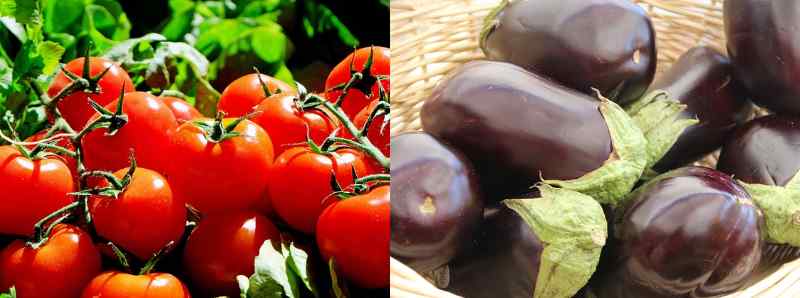
Tomatoes and eggplants are types of vegetables that are botanically classified as fruits
On the list of the most popular vegetables are some types of plants that are, botanically speaking, classified as fruits , but used in the culinary world as vegetables.
Let’s look at some of the most common vegetables that are classified as fruits.
Tomatoes are an important type of vegetable (or technically fruit) that are an integral part of most cuisines in the world.
There are many types of tomatoes that come in all shapes, sizes, and colors. There are small cherry tomatoes, medium-sized plum tomatoes, and large beefsteak tomatoes. Some varieties of tomatoes are golden yellow and others are dark green when mature (Kumato).
Tomatoes contain vitamins A, C, E, and K, as well as most B-group vitamins. All varieties of tomatoes have moderate amounts of minerals and some fiber.
The benefits from tomatoes come from the antioxidant called lycopene. ( 27 )

Technically, cucumbers are a variety of fruit. However, we mainly use fresh cucumber as a nutritious type of vegetable.
There are thought to be over 100 varieties of this type of long green vegetable. Cucumbers are consumed fresh in salads or pickled, where they are referred to as gherkins.
Cucumbers are low in calories, fiber, and protein. However, they contain good amounts of important vitamins and minerals as well as antioxidants. The best way to eat cucumber is with their peel on to increase your fiber intake. ( 28 )
While we think of eggplant as a large purple-skinned type of vegetable, it is actually a fruit.
Eggplants belong to the nightshade family of plants that also include potatoes, bell peppers, and tomatoes.
The main nutritional benefits of eggplants come from the fiber content and antioxidants of their dark-colored skin. One cup of chopped eggplant contains nearly 3 g of fiber (11% RDI) and just 4.7 g of carbs. There are only 19 calories in this serving of eggplant. ( 29 )
The dark skin of eggplant means that it is rich in antioxidants such as anthocyanins. ( 30 )
Other varieties of fruits we consume as vegetables
Squash is a member of the gourd family that also includes pumpkins and zucchini (courgette). Squash vegetables contain nutrients such as vitamin A and C. ( 31 )
Avocados are botanically a type of fruit that are often used as a vegetable. They are a good source of protein, vitamins, fiber, and fats. ( 32 )
Types of Vegetables that are Actually Edible Flowers
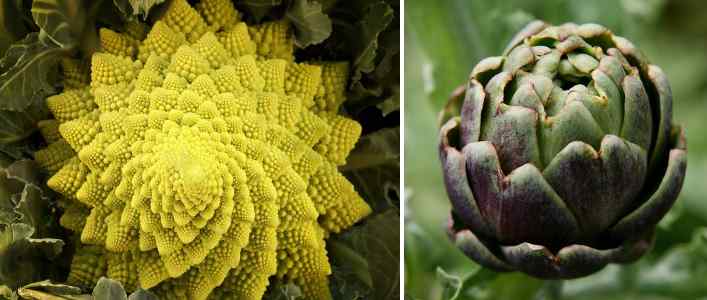
Types of vegetables: edible flowers
Some types of plants produce edible flowers. However, you may not think of these vegetable varieties as your typical type of flower .
Here are some of the most common vegetable flowers that we consume:

Broccoli is actually a cruciferous type of vegetable that grows green florets.
As with many green vegetables, broccoli is a good source of many nutrients. In fact, broccoli is such a nutritious type of vegetable that it is on the list of superfoods.
For example, half a cup of cooked, chopped broccoli florets contains minerals such as calcium, iron, and potassium. This amount of broccoli has impressive levels of vitamins. You get 24% of your vitamin A RDI, over 80% of your vitamin C RDI, and a massive 138% of vitamin K! ( 33 )
Cauliflower

Cauliflowers
As its name suggests, cauliflower is a type of edible flower vegetable that is grouped together with cabbage, Brussels sprouts, and broccoli.
The most common variety of cauliflower is the type with white florets. However, other interesting varieties of this vegetable flower include green cauliflower, orange cauliflower, Romanesco cauliflower, and purple cauliflower.
You can eat cauliflower raw, boiled, pan-fried, and, everyone’s favorite – cauliflower cheese.
A 100 g serving of cooked cauliflower only contains 23 calories. This cruciferous vegetable is low in carbs, fat and high in fiber. It also contains good amounts of necessary vitamins and minerals. ( 34 )

Globe Artichoke
Artichoke flowers are the edible part of the artichoke plant and look like a round ball on top of the stem. This is a reason why it is also called the globe artichoke.
The type of artichoke flower shouldn’t be confused with the Jerusalem artichoke which is a type of root vegetable.
Artichokes provide a good number of vitamins and minerals. Possibly, the most outstanding nutritional value of artichoke flowers is its range of antioxidants.
It is claimed that the artichoke plant is one of the top vegetables in terms of total antioxidant levels . Artichokes contain antioxidants such as apigenin, luteolin, and cynarine. ( 35 )
Types of Fungi

Mushrooms are used as vegetables
Fungi are not classified as a type of vegetable, fruit, or any other kind of plant. They are a particular type of food in a class of their own. However in the culinary world many people use them as vegetables.
There are a number of types of edible fungi that are delicious and very good for you. Learn more about the best varieties of mushrooms to eat .
Sea Vegetables
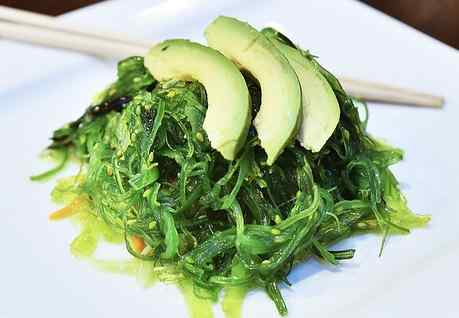
Wakama (sea vegetable) salad
Sea vegetables are types of edible seaweed that some people say are some of the healthiest vegetables. One example of it is kelp. Other examples include nori, wakama, dulse and spirulina.
One of the reasons why various types of seaweed are considered very good for you is due to their high levels of phytonutrients. Studies show that sea vegetables contain unique benefits not found in “terrestrial” food. Seaweed is high in vitamins A, B, C, and E as well as being an important iron source for non-meat eaters. ( 36 )
Related articles:
- Types of Fruits: List of Fruits with Their Pictures
- Types of Potatoes: Ultimate Guide to Different Kinds of Potatoes
- Types of Olives: 28 Tasty Varieties of Olives You Should Try

59 Different Types of Vegetables (and Their Nutrition Profiles)
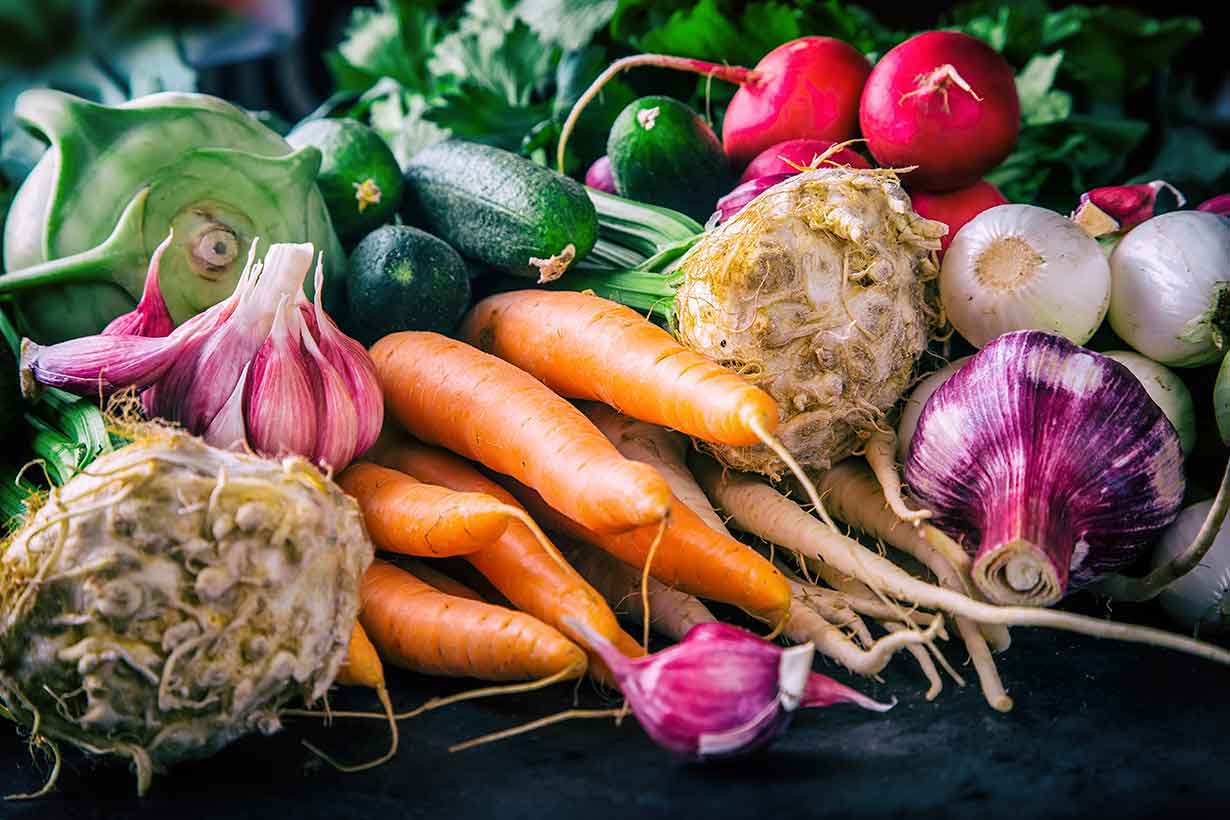
Vegetables are healthy and nutritious foods .
This article provides a list of 59 types of vegetables and their nutrition profiles.
If you’re looking for a specific vegetable, you can use the menu below.
On the other hand, just keep reading for an A to Z list of popular (and lesser-known) vegetables.
For each vegetable, you can see the nutrition profile per 100g unless otherwise stated.
This includes the carbohydrate, fat, and protein content and the most significant vitamins and minerals.
Types of Vegetables
1. Artichoke
Artichoke (or artichoke heart) is a kind of thistle.
Interestingly, this vegetable is actually the flower buds of the plant before they bloom.
Nutritionally, artichokes offer a decent mix of vitamins and minerals per 100g ( 1 );
- Calories: 47 kcal
- Carbohydrate: 10.5 g
- Fiber: 5.4 g
- Sugar: 1.0 g
- Protein: 3.3 g
- Vitamin C: 20% RDA
- Vitamin K1: 18% RDA
- Folate: 17% RDA
- Magnesium: 15% RDA
- Manganese: 13% RDA
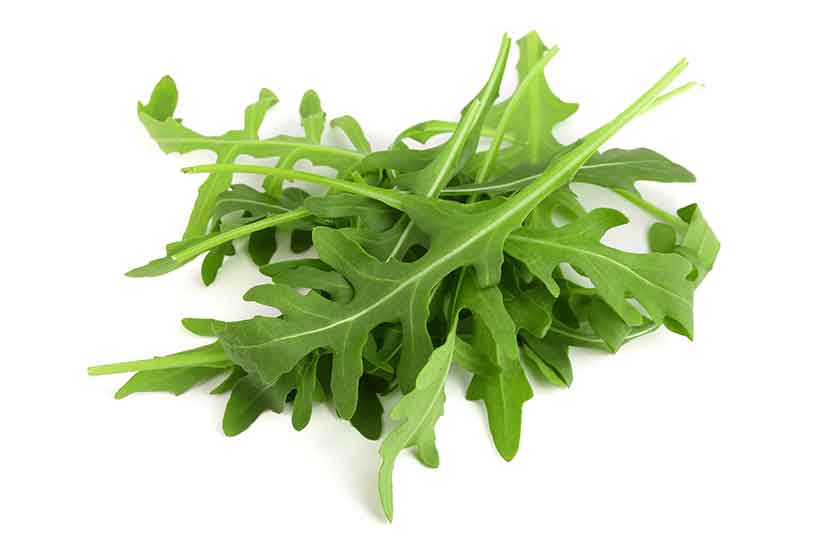
Arugula leaves are otherwise known as ‘rocket’, and they are particularly popular in the Mediterranean and Middle-East.
In fact, arugula is one of the tastiest foods on this vegetable list, and it adds a complex flavor to any dish.
These leaves are relatively nutrient-dense too, and their nutritional profile looks like the following ( 2 );
- Calories: 25 kcal
- Carbohydrate: 3.7 g
- Fiber: 1.6 g
- Sugar: 2.1 g
- Fat: 0.7 g
- Protein: 2.6 g
- Vitamin K1: 136% RDA
- Vitamin A: 47% RDA
- Vitamin C: 25% RDA
- Folate: 24% RDA
- Calcium: 16% RDA
3. Asparagus

Out of all the different vegetables in the world, asparagus has a good argument for being the tastiest.
After all, it’s often the one which steakhouses serve alongside the main attraction.
As well as being one of the tastiest vegetables, it provides a good source of nutrition too ( 3 );
- Calories: 20 kcal
- Carbohydrate: 4.0 g
- Fiber: 2.1 g
- Sugar: 1.9 g
- Fat: 0.1 g
- Protein: 2.2 g
- Vitamin K1: 52% RDA
- Vitamin A: 15% RDA
- Folate: 13% RDA
- Iron: 12% RDA
- Vitamin B1: 10% RDA
4. Bell Peppers
Bell peppers come in all colors, shapes, and sizes.
However, they all taste a little bit different, and red bell peppers are a little sweeter than yellow bell peppers. In the same fashion, yellow bell peppers are slightly sweeter than green bell peppers.
Technically bell peppers are a fruit, but since most people use them as a vegetable, they make this list.
Nutritionally, each color pepper has a very slight difference, but they are fairly similar.
Here is the nutrition profile for a large yellow bell pepper ( 4 );
- Calories: 27 kcal
- Carbohydrate: 6.3 g
- Fiber: 0.9 g
- Fat: 0.2 g
- Protein: 1.0 g
- Vitamin C: 306% RDA
- Vitamin B6: 8% RDA
- Folate: 6% RDA
- Potassium: 6% RDA
- Manganese: 6% RDA
See this article on the nutritional benefits of bell peppers for more a full guide.
5. Beet Greens

The leaves of the beetroot plant are incredibly nutritious, so don’t throw them away!
Out of all plant foods, beet greens are one of the most impressive for nutrient density ( 5 );
- Calories: 22 kcal
- Carbohydrate: 4.3 g
- Fiber: 3.7 g
- Sugar: 0.5 g
- Vitamin K1: 500% RDA
- Vitamin A: 127% RDA
- Vitamin C: 50% RDA
- Potassium: 22% RDA
- Manganese: 20% RDA
See this guide to leafy greens for an in-depth look at the nutritional benefits of leafy vegetables.
6. Beets / Beetroot
Depending on where you are from, beets (or beetroot) goes by different names.
Beets are a root vegetable, and they are quite adaptable too. For instance, they can be boiled, fried, roasted, mashed, or you can even buy pickled beets .
Consuming beets leads to a large intake of nitrate, which has many purported health benefits. Most notably, nitrate helps to lower blood pressure ( 6 ).
This vegetable also has a reasonably decent mix of micronutrients ( 7 );
See here for a full guide to beets
- Calories: 43 kcal
- Carbohydrate: 9.6 g
- Fiber: 2.8 g
- Sugar: 6.8 g
- Protein: 1.6 g
- Folate: 27% RDA
- Manganese: 16% RDA
- Potassium: 9% RDA
- Vitamin C: 8% RDA
- Magnesium: 6% RDA
7. Bok Choy

Some people call it ‘Chinese cabbage’, but the proper translation is bok choy.
Bok choy belongs to the cruciferous vegetable family, alongside others such as cabbage and brussels sprouts.
It’s a tasty vegetable that features in a wide variety of Asian dishes, and it’s rich in nutrients too ( 8 );
- Calories: 13 kcal
- Carbohydrate: 2.2 g
- Fiber: 1.0 g
- Sugar: 1.2 g
- Protein: 1.5 g
- Vitamin A: 89% RDA
- Vitamin C: 75% RDA
- Vitamin K: 57% RDA
- Folate: 16% RDA
- Calcium: 11% RDA
Learn more about bok choy here .
8. Bottle Gourd
Bottle gourd is a member of the squash family, and it has a unique hourglass shape.
In addition to offering vitamin C and a moderate amount of fiber, bottle gourd is a rich source of phytonutrients.
Nutritionally, 100 grams (raw weight) of bottle gourd provides ( 9 ):
- Calories: 14 kcal
- Carbohydrate: 3.39 g
- Fiber: 0.5 g
- Fat: 0.02 g
- Protein: 0.62 g
- Vitamin C: 11% DV
- Zinc: 6% DV
- Potassium: 3% DV
- Copper: 3% DV
- Manganese: 3% DV
For more information, see this guide to bottle gourd:
5 Nutritional Benefits of Bottle Gourd (Calabash)
9. Broccoli
Broccoli is another nutritious cruciferous vegetable, and numerous studies show it can lower the risk of various cancers ( 10 , 11 ).
Interestingly, wild broccoli doesn’t exist, and the vegetable was “made” by man through selectively breeding cabbage plants.
Man-made or not, it has an impressive range of nutrients ( 12 ):
- Calories: 34 kcal
- Carbohydrate: 6.6 g
- Fiber: 2.6 g
- Sugar: 1.7 g
- Fat: 0.4 g
- Protein: 2.8 g
- Vitamin C: 149% RDA
- Vitamin K1: 127% RDA
- Vitamin A: 12% RDA
- Manganese: 13% RDA
10. Broccoli Rabe (Rapini)

A lesser-known vegetable is broccoli rabe (also called ‘rapini’).
Despite containing the broccoli name and belonging to the same family of plants, they are two separate vegetables.
Rapini has a strong, flavorful but slightly bitter taste, and it’s commonly found in the Mediterranean region’s cuisine.
Nutritionally speaking, broccoli rabe has a lot to offer ( 13 );
- Carbohydrate: 3.1 g
- Fiber: 2.7 g
- Sugar: 0.4 g
- Fat: 0.5 g
- Protein: 3.2 g
- Vitamin K1: 280% RDA
- Vitamin A: 52% RDA
- Vitamin C: 34% RDA
- Folate: 21% RDA
11. Brussels Sprouts
Brussels sprouts are one of the more interesting looking plant foods. In fact, they look like little mini cabbages.
Sprouts belong to the cruciferous category of vegetables, and they share some common benefits with broccoli and cabbage.
They taste particularly good with a roast dinner or mixed with bacon.
A look at their nutritional values show they’re a good choice of vegetable too ( 14 );
- Carbohydrate: 9 g
- Fiber: 3.8 g
- Sugar: 2.2 g
- Protein: 3.4 g
- Vitamin K1: 221% RDA
- Vitamin C: 142% RDA
- Manganese: 117% RDA
- Folate: 15% RDA
- Vitamin A: 15% RDA
12. Butternut Squash

Butternut squash is the second on this vegetable list that is technically a fruit. However, similar to bell peppers, everyone uses it as a vegetable.
Butternut squash has a taste not dissimilar to a pumpkin, with a sweet and nutty flavor.
It is also very adaptable, and features in a wide range of recipes whether grilled or roasted, or in soups and porridge.
With a bright orange flesh, this squash is also very high in vitamin A ( 15 );
- Calories: 40 kcal
- Carbohydrate: 10 g
- Sugar: 2.0 g
- Protein: 0.9 g
- Vitamin A: 223% RDA
- Manganese: 9% RDA
- Potassium: 8% RDA
- Magnesium: 7% RDA
13. Cabbage (Green)
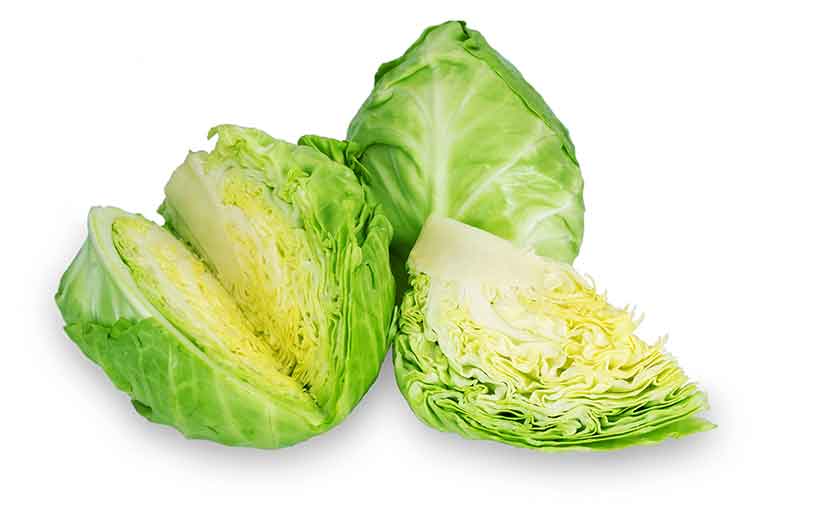
Cabbage is a large-headed green vegetable that has close botanical links to broccoli, cauliflower, and brussels sprouts.
Cabbage belongs to the cruciferous category of vegetables and like others, it has links to similar anti-cancer health benefits.
Nutritionally, they offer ( 16 );
- Carbohydrate: 5.8 g
- Fiber: 2.5 g
- Sugar: 3.2 g
- Protein: 1.3 g
- Vitamin K1: 95% RDA
- Vitamin C: 61% RDA
- Folate: 11% RDA
- Manganese: 8% RDA
- Vitamin B6: 6% RDA
14. Cabbage (Red)
Green and red cabbage are different in color, but they are basically the same type of vegetable.
Despite a similar appearance, the major contrast is the dark red/purple leaves of red cabbage.
Interestingly, the nutrient profile of red cabbage is slightly different, and it offers more in the way of vitamins and minerals ( 17 );
- Calories: 31 kcal
- Carbohydrate: 7.4 g
- Sugar: 3.8 g
- Protein: 1.4 g
- Vitamin C: 95% RDA
- Vitamin K1: 48% RDA
- Vitamin A: 22% RDA
- Manganese: 12% RDA
- Vitamin B6: 10% RDA
15. Carrots

Carrots are a sweet-tasting, bright orange root vegetable.
See here for a full guide to root vegetables .
However, it is possible to find rarer cultivars of the vegetable that are red , yellow and even black.
Carrots grow underground, and they are mainly known for their high vitamin A (in the form of beta-carotene) content.
That said, it’s essential to eat them with a source of fat if you want to absorb this (fat-soluble) vitamin.
For instance, we can only digest 3% of the vitamin in raw carrots. This figure rises to 39% in carrots cooked with fat ( 18 ).
Here are the nutrition values in full ( 19 );
- Calories: 41 kcal
- Sugar: 4.7 g
- Vitamin A: 334% RDA
- Vitamin K1: 16% RDA
- Vitamin C: 10% RDA
- Vitamin B6: 7% RDA
See this guide to the nutritional benefits of carrots for more information.
16. Cauliflower
Right now, cauliflower is one of the most popular types of vegetables around.
You can find all sorts of cauliflower products, ranging from cauliflower rice to mashed cauliflower.
For home-baking enthusiasts, cauliflower pizza is even a thing. In my opinion, though, cauliflower cheese will always be the best.
On the positive side, this vegetable is reasonably nutritious too; the macro and micronutrient composition looks like this ( 20 );
- Carbohydrate: 5.3 g
- Sugar: 2.4 g
- Protein: 2.0 g
- Vitamin C: 77% RDA
- Vitamin K1: 20% RDA
- Folate: 14% RDA
- Vitamin B6: 11% RDA
- Potassium: 9% RDA

Usually eaten in its raw state, celery is a popular salad vegetable with high water content.
Notably, quite a lot of research shows that celery may have some interesting health properties too.
According to one systematic review, the vegetable can have a positive impact on fertility ( 21 ).
Celery offers the following vitamins and minerals ( 22 );
- Calories: 16 kcal
- Carbohydrate: 11.7 g
- Sugar: 1.8 g
- Protein: 0.7 g
- Vitamin K1: 37% RDA
- Vitamin A: 9% RDA
- Folate: 9% RDA
- Potassium: 7% RDA
- Manganese: 5% RDA
Chives provide a delicious flavor to any dish, and they also taste great on their own.
Often used as a flavoring herb, chives are a key feature in French cuisine, and a little goes a long way.
Slightly similar to regular chives, garlic chives (or ‘Chinese chives’) are another variety of this vegetable. However, these are used more like a standard vegetable than like a herb.
Chives are very nutrient-dense, and they supply ( 23 );
- Calories: 30 kcal
- Carbohydrate: 15.9 g
- Vitamin K1: 266% RDA
- Vitamin C: 97% RDA
- Vitamin A: 87% RDA
- Folate: 26% RDA
- Manganese: 19% RDA

19. Collard Greens

As their name may suggest, collard greens are a leafy green vegetable.
This vegetable is popular throughout the world, and it is usually served either boiled, steamed, or in stews.
Collard greens have a slightly bitter flavor, and they provide a wide range of nutrients.
In fact, they are among the most nutrient-dense options on this list of vegetables ( 24 );
- Carbohydrate: 5.7 g
- Fiber: 3.6 g
- Protein: 2.5 g
- Vitamin K1: 638% RDA
- Vitamin A: 133% RDA
- Vitamin C: 59% RDA
- Folate: 41% RDA
- Manganese: 14% RDA
20. Crookneck Squash
Some types of veggies have strange names, and this one certainly belongs to that group.
The crookneck squash is a bright yellow vegetable with a crooked hook-like neck.
Similar to other vegetables in the squash category, crookneck squashes have a mild, buttery taste.
Nutrient-wise, they supply ( 25 );
- Carbohydrate: 5.5 g
- Fiber: 1.4 g
- Sugar: 2.3 g
- Vitamin C: 11% RDA
- Magnesium: 7% RDA
- Vitamin K1: 7% RDA
21. Daikon Radish

The daikon radish is native to East and South-East Asia.
Daikon radish has numerous culinary uses, and many different pickles, salads, soups and stews are made with it.
It is very low in calories, yet supplies a reasonable range of nutrients ( 26 );
- Calories: 18 kcal
- Carbohydrate: 4.1 g
- Sugar: 2.5 g
- Protein: 0.6 g
- Vitamin C: 37% RDA
- Copper: 6% RDA
- Magnesium: 4% RDA
For more information, see this complete nutritional guide to daikon radish:
5 Benefits of Daikon Radish (and Full Nutritional Values)
22. Dandelion Greens
Dandelion greens are another leafy green with impressive nutrient density.
We often eat them raw, and they have a bitter and slightly peppery taste. However, like many vegetables, they have a more pleasant flavor after cooking.
Dandelion greens are high in calcium, and they provide a rare source of vitamin E too. The overall nutrient profile looks like this ( 27 );
- Calories: 45 kcal
- Carbohydrate: 9.2 g
- Fiber: 3.5 g
- Sugar: 0.7 g
- Protein: 2.7 g
- Vitamin K1: 973% RDA
- Vitamin A: 203% RDA
- Vitamin C: 58% RDA
- Calcium: 19% RDA
- Vitamin E: 17% RDA
23. Eggplant (Aubergine)

While it goes by the name of eggplant in the US, the UK uses the French name of aubergine.
This vegetable belongs to the nightshade family of plants, alongside others such as tomatoes, bell peppers, and tomatillos.
It seems that with eggplant, people either love it or hate it – and the way of cooking probably has a lot to do with it.
Boiled eggplant? Not so tasty.
On the other hand, roasted eggplant cooked with some fat tastes delicious.
Eggplants offer the following nutrients ( 28 );
- Calories: 24 kcal
- Fiber: 3.4 g
- Folate: 5% RDA
- Vitamin C: 4% RDA
- Copper: 4% RDA
Endive, otherwise known as chicory, is a leafy green vegetable that has a bitter, yet slightly sweet taste.
It belongs to the same family of vegetables as radicchio and curly endive.
Endive is a relatively nutrient-rich vegetable that people often use in salad, but it tastes much better grilled ( 29 );
- Calories: 17 kcal
- Carbohydrate: 3.4 g
- Fiber: 3.1 g
- Sugar: 0.3 g
- Vitamin K1: 289% RDA
- Vitamin A: 43% RDA
- Folate: 35% RDA
- Manganese: 21% RDA
- Vitamin C: 11% RDA
There are two main types of endive: curly endive and escarole. You can find a guide to the nutritional benefits of escarole here:
5 Benefits of Escarole (With Full Nutrition Facts)
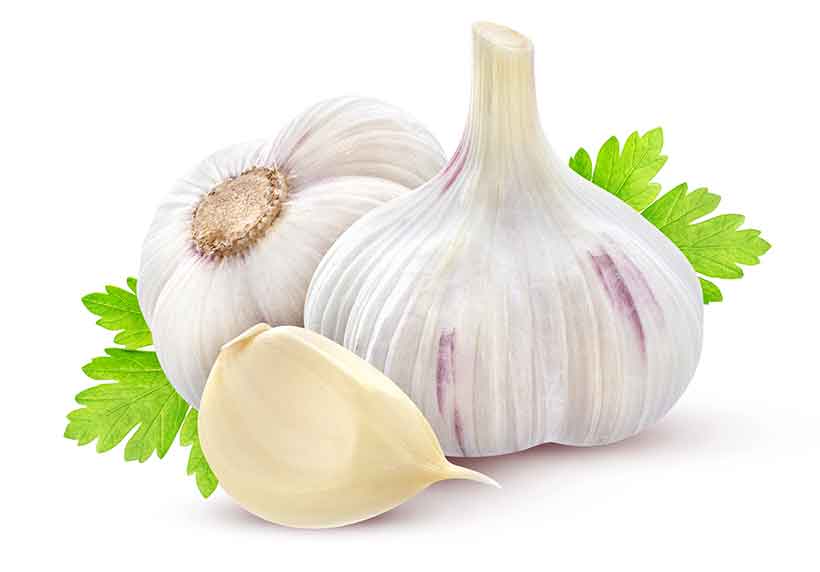
Garlic is one of those types of vegetables that confuses people; is it truly a vegetable?
Or is it a herb?
While some people refer to garlic as a herb, it is a type of bulb, and it is more accurate to call it a root vegetable.
However, although roasted garlic tastes delicious, garlic is frequently used in small doses as a herb for flavoring.
Garlic has a lot of research behind it, and studies indicate that it may help with lowering blood pressure ( 30 ).
Nutritionally, it offers ( 31 );
- Calories: 149 kcal
- Carbohydrate: 33.1 g
- Fiber: 2.1 g
- Protein: 6.4 g
- Manganese: 84% RDA
- Vitamin B6: 62% RDA
- Vitamin C: 52% RDA
- Selenium: 20% RDA
- Calcium: 18% RDA
Garlic belongs to the allium family of vegetables. For more information on these specific vegetables, please refer to the following guide:
A List of Allium Vegetables and Their Nutritional Benefits
26. Green Amaranth Leaves
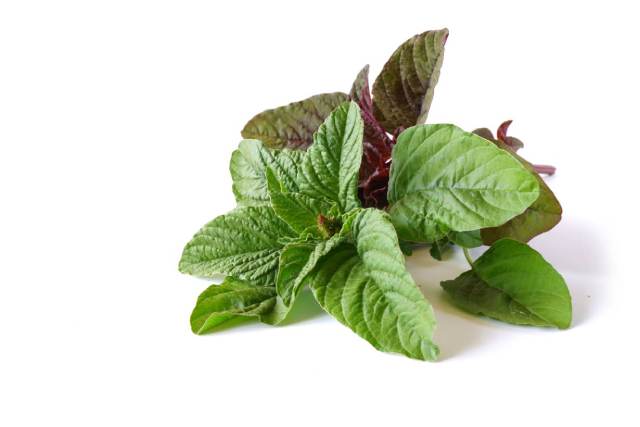
Green amaranth leaves are a nutritious green vegetable that has a similar nutritional profile to spinach.
These leafy greens have a mild and enjoyable sweet, nutty taste, and they are very popular in Chinese cuisine.
Nutritionally, 100 grams of these leaves provides ( 32 ):
- Calories: 23 kcal
- Carbohydrate: 4.02 g
- Fat: 0.33 g
- Protein: 2.46 g
- Vitamin K1: 950% DV
- Vitamin C: 48% DV
- Manganese: 39% DV
- Copper: 18% DV
- Calcium: 17% DV
For more information, see here: Green Amaranth Leaves: A Nutritional Guide
27. Green Onion (Spring Onion)
Green (or spring) onions are a vegetable closely related to others in the Allium family, such as garlic, chives, and onions.
They have a similar (but milder and sweeter) taste to regular onions.
Green onions taste great when grilled whole and they also add a lot of flavor to stews and other dishes.
Also, this vegetable is relatively dense in vitamins – notably vitamins A, C, and K ( 33 );
- Carbohydrate: 5.6 g
- Fiber: 3.5 g
- Protein: 1.8 g
- Vitamin K1: 209% RDA
- Vitamin A: 80% RDA
- Vitamin C: 76% RDA
- Iron: 11% RDA
- Vitamin B2: 8% RDA
28. Jicama (Mexican Yam Bean)

Jicama is a kind of tuberous vegetable that is native to Mexico.
Tuberous vegetables are commonly known as ‘tubers’ and you can learn more about them here:
Types of Tubers and Their Nutritional Values
On the outside, jicama looks a little bit like an onion, with a yellow exterior and white inner flesh.
In terms of taste and texture, it is sweet and crunchy.
This root vegetable has a high water content, and it’s also high in fiber and vitamin C ( 34 );
- Calories: 38 kcal
- Fiber: 4.9 g
- Potassium: 4% RDA
- Magnesium: 3% RDA
- Manganese: 3% RDA

Kale is a member of the cruciferous family of vegetables, and it shares some similarities to cabbage and broccoli.
Personally, I’m not a huge fan of kale’s bitter taste. However, it has rapidly grown in popularity over the past several years as people find out about its health properties.
In terms of nutrients, kale has a shout for being one of the healthiest vegetables out there.
Kale provides an enormous amount of vitamin K1, beta-carotene, and vitamin C ( 35 );
- Calories: 50 kcal
- Fiber: 2.0 g
- Vitamin K1: 1021% RDA
- Vitamin A: 308% RDA
- Vitamin C: 200% RDA
- Manganese: 39% RD
- Calcium: 14% RDA
For more information, see this full guide to kale .

Kimchi is a spicy fermented cabbage side-dish originating in Korea.
It combines cabbage, garlic, ginger, red chili pepper, salt, and fermented fish sauce.
Kimchi isn’t a vegetable as such, but it’s very popular and so different to regular cabbage.
In addition to the nutrients present in cabbage, garlic, and ginger, kimchi provides a host of probiotic bacteria.
Also, due to the fermentation process, the nutrients in all the vegetables are easier to digest and absorb ( 36 ).
Nutritionally, a typical kimchi provides the following carbohydrate, fat and protein content ( 37 );
- Calories: 15 kcal
- Carbohydrate: 2.4 g
- Protein: 1.1 g
31. Kohlrabi
Kohlrabi is an interesting looking vegetable; it looks something like a turnip with long large green leaves.
It is a biennial type of vegetable, which makes it a flowering plant with a two-year lifecycle.
For example, this means the vegetable will only bloom after two years.
Kohlrabi is primarily a good source of vitamin C ( 38 );
- Carbohydrate: 6.2 g
- Fiber: 3.6 g
- Sugar: 2.6 g
- Protein: 1.7 g
- Vitamin C: 103% RDA
- Potassium: 10% RDA
- Manganese: 7% RD
- Copper: 14% RDA

Leeks are a tasty vegetable that add a lot of flavor when used in cooking.
They are long, with greenish-white stalks reminiscent of green onions, another member of the allium family.
However, leeks have a much sweeter and milder taste.
Concerning their nutritional value, leeks provide a varied mix of vitamins and minerals ( 39 );
- Calories: 61 kcal
- Carbohydrate: 14.2 g
- Fiber: 1.8 g
- Sugar: 3.9g
- Fat: 0.3 g
- Vitamin K1: 59% RDA
- Vitamin A: 33% RDA
- Manganese: 24% RDA
- Vitamin C: 20% RDA
See this full guide to leeks for more information on their potential benefits.
33. Lettuce
Lettuce is one of the most popular varieties of vegetables.
You can find it pretty much everywhere too; burgers, sandwiches, salads, or just decorating the sides of a plate.
Lettuce has an extremely high water content, which makes it quite crisp and refreshing.
Nutritionally it’s not so bad either; lettuce provides a lot of nutrients for minimal energy ( 40 );
- Carbohydrate: 2.8 g
- Fiber: 1.3 g
- Sugar: 0.8g
- Vitamin K1: 141% RDA
- Vitamin A: 148% RDA
- Vitamin C: 30% RDA
- Manganese: 130% RDA
- Folate: 10% RDA
34. Lotus Root
Lotus root is a versatile root vegetable that is relatively uncommon in Western countries.
However, lotus root is a common vegetable in India and East Asia, and it can be used in a variety of ways.
Per 100 grams, cooked lotus root provides ( 41 ):
- Calories: 66 kcal
- Carbohydrate: 16.0 g
- Fiber: 3.1 g
- Sugar: 0.5g
For more information, see this complete guide:
5 Benefits of Lotus Root (With Nutrition Facts)
35. Mushrooms

Among this list of vegetables, mushrooms stand alone.
Because they are not technically a vegetable, a fruit, or any other kind of plant. They belong to a class of their own.
However, since we commonly use mushrooms in the same way as vegetables, here they are.
Mushrooms contain a vast range of phytonutrients, some of which are unique. Additionally, numerous studies show they have anti-inflammatory and anti-microbial properties ( 42 ).
As shown below, mushrooms contain some vitamins and minerals too ( 43 );
See here for an in-depth guide to all edible mushrooms
- Carbohydrate: 16.1 g
- Fiber: 0.6 g
- Sugar: 1.7g
- Selenium: 37% RDA
- Vitamin B2: 29% RDA
- Copper: 25% RDA
- Vitamin B3: 19% RDA
- Vitamin B5: 15% RDA
36. Mustard Greens
Mustard greens are another nutrient-dense leafy green.
Depending on where you are in the world, you may also hear people refer to them as Chinese, Indian, Oriental or vegetable mustard.
These leaves have a peppery taste to them, and they are often eaten raw in salads (or juiced).
However, like many vegetables, they taste much better after cooking; sauteed mustard greens in garlic butter is a delicious side to meat/fish.
Similar to other leafy green vegetables, mustard greens are packed with nutrients ( 44 );
- Calories: 26 kcal
- Carbohydrate: 4.9 g
- Fiber: 3.3 g
- Sugar: 1.6g
- Vitamin K1: 622% RDA
- Vitamin A: 210% RDA
- Vitamin C: 117% RDA
- Folate: 47% RDA
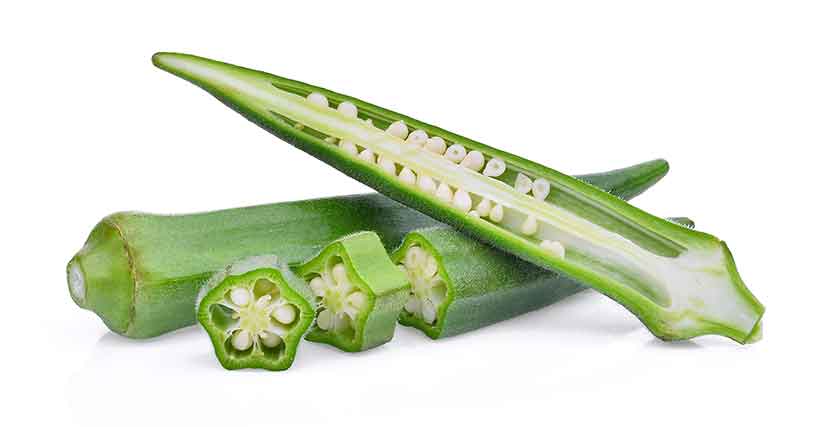
Okra is an unusual looking vegetable, and it is otherwise known as ‘ladies’ fingers’.
The vegetable has green stems that contain edible seeds, and both the outer and inner of the vegetable are eaten.
Okra can be served raw, cooked, and we can sometimes find it in salads.
It has a notably slimy texture.
Here are the nutritional properties of okra ( 45 );
- Carbohydrate: 7.0 g
- Fiber: 3.2 g
- Sugar: 1.2g
- Vitamin K1: 66% RDA
- Manganese: 50% RDA
- Vitamin C: 35% RDA
- Folate: 22% RDA
- Magnesium: 14% RDA
38. Onions (Red)
Onions come in many varieties, but perhaps the most distinctive contrast is between the red and yellow onion.
Red onions have a lot of benefits too; they are more mild and sweet in taste, and they also contain more phytonutrients.
Similar to other dark red/blue plant foods, red onions are rich in a health-protective polyphenol called anthocyanins ( 46 ).
Red onions provide ( 47 );
- Carbohydrate: 9.0 g
- Sugar: 4.0g
- Fat: 0 g
39. Onions (Yellow)

Yellow onions are perhaps the most popular vegetable in the allium family.
It’s hard to pinpoint the taste of onions, but they are slightly sweet, spicy, bitter, and flavorful, all at the same time.
Grilled onions taste delicious, especially in combination with garlic and some steak.
However, most people use onions for flavoring, and adding chopped onions to a dish always boosts the taste.
The main nutrient that onions provide is vitamin C ( 48 );
- Carbohydrate: 9.3 g
- Fiber: 1.7 g
- Sugar: 4.2g
- Vitamin C: 12% RDA
- Vitamin B6: 6% RDA
- Folate: 5% RDA
- Potassium: 4% RDA
40. Parsnips
My favorite vegetable as a child was always parsnips.
They may look like a white carrot, but they taste completely different.
Parsnips are another biennial type of plant, and they are very versatile in the kitchen.
For example, we can roast, boil, or mash parsnips, or use them to make a variety of stews, soups,
Parsnips have a soft texture with a nutty/sweet flavor, and roasting them in the oven tastes particularly good,
Nutritionally, they are a good source of several nutrients ( 49 );
- Calories: 75 kcal
- Carbohydrate: 18.0 g
- Sugar: 4.8g
- Protein: 1.2 g
- Vitamin C: 28% RDA
- Manganese: 28% RDA
- Vitamin K1: 28% RDA
- Potassium: 11% RDA
For more on parsnips, see this complete guide to parsnips and their nutritional values .
41. Potatoes

While a traditional staple food in the East is rice, potatoes fill that bracket for much of the West.
Interestingly, there are many different types of potatoes , each of which have their own unique characteristics.
Nutritionally, potatoes are one of the higher carbohydrate sources on this list of vegetables.
However, they are not as high in carbs as many people presume. At around 18g carbohydrate per 100g, they are a lot lower than legumes and grains – and even some other vegetables.
Nutritionally, they provide a good source of potassium and vitamin C ( 50 );
- Calories: 77 kcal
- Carbohydrate: 18.4 g
- Fiber: 2.2 g
- Vitamin C: 33% RDA
- Vitamin B6: 15% RDA
- Potassium: 12% RDA
- Manganese: 8% RDA
- Phosphorus: 6% RDA
Find out more about the nutritional benefits of potatoes here.
42. Pumpkin
Pumpkins are a kind of vegetable that become particularly popular at one time of year – Halloween.
They are delicious too, and after cooking, they provide a soft, sweet flesh that is quite nutritious also.
Although people use pumpkin as a vegetable, it isn’t a true veggie. Due to its flesh and seeds, it is botanically a fruit.
Pumpkins are an excellent source of vitamin A (as beta-carotene) ( 51 );
- Carbohydrate: 6.5 g
- Fiber: 0.5 g
- Sugar: 1.4g
- Vitamin C: 15% RDA
- Copper: 6% RDA
- Manganese: 6% RDA
43. Purple Sweet Potato (Okinawan Yam)
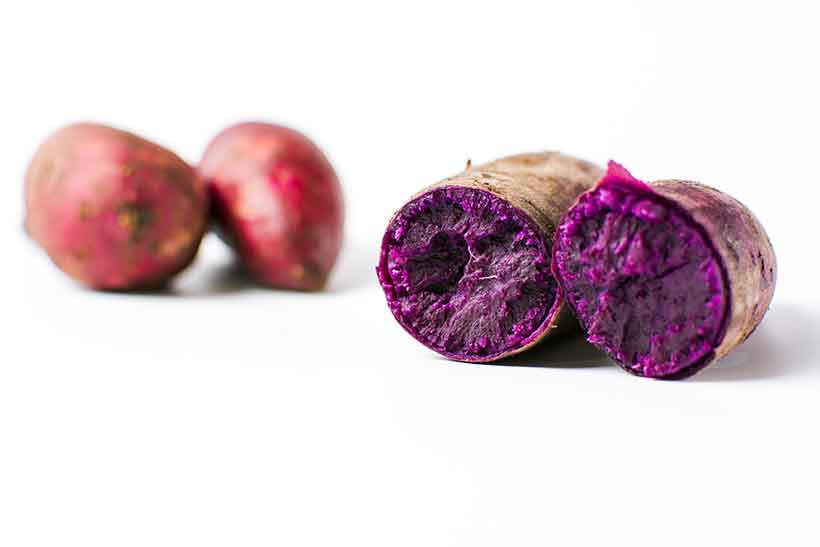
Although they look like different vegetables, the ‘Okinawan yam’ is a kind of sweet potato.
This purple sweet potato is a nutritious tuber that has some advantages over regular sweet potatoes.
For one thing, the brilliant purple color of this vegetable is due to the abundant supply of anthocyanins in the flesh.
The traditional long-lived Okinawans consumed most of their calories from purple sweet potatoes too.
As carbohydrate sources go, they’re certainly a better choice than the refined carbs in Western diets.
Purple sweet potatoes provide ( 52 );
- Calories: 67 kcal
- Carbohydrate: 16.3 g
- Vitamin B6: 9% RDA
- Vitamin B1: 7% RDA
See here for a full nutritional guide to purple sweet potatoes.
44. Radicchio
Radicchio is a kind of chicory plant.
It originates in Italy and, for this reason, often goes by the name of ‘Italian chicory’.
This vegetable has a deep red to purple color, and it looks a little like the leaves of red cabbage.
Despite its color, radicchio is often classed as a “leafy green”.
It belongs to the leaf category of vegetables alongside others like spinach and swiss chard.
Similar to other leafy vegetables, radicchio is very rich in vitamin K1 ( 53 );
- Carbohydrate: 4.5 g
- Fiber: 0.9 g
- Sugar: 0.6g
- Vitamin K1: 319% RDA
- Copper: 17% RDA
- Vitamin C: 13% RDA
- Vitamin E: 11% RDA
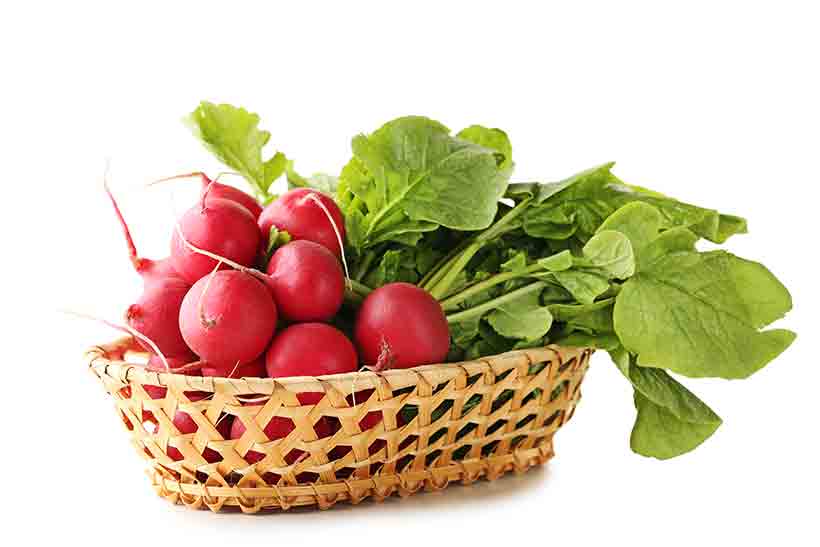
Radish is a small edible root vegetable with a red to pink color.
Radishes are popular throughout the world, and they are commonly eaten as a raw salad vegetable.
This root vegetable has a very bold taste too; crunchy, peppery and slightly spicy.
Radishes are very low in energy density, and they supply a reasonable amount of vitamin C ( 54 );
- Carbohydrate: 3.5 g
- Fiber: 1.6 g
- Sugar: 1.9g
- Potassium: 7% RDA
- Vitamin B6: 4% RDA
- Copper: 3% RDA
46. Swede (Rutabaga)
Despite being known throughout the world as ‘Swede’, this vegetable has the name of ‘rutabaga’ in the United States.
Not too surprisingly, Swedes originate from Sweden, where cultivation has occured for centuries.
Swedes are not an original vegetable, and they are a hybrid of cabbage and turnips.
We can eat this root vegetable in a variety of ways, from roasting, boiling and mashing, or even making chips/crisps.
Swedes are relatively high in vitamin C ( 55 ):
- Calories: 37 kcal
- Carbohydrate: 8.62 g
- Fiber: 2.3 g
- Sugar: 4.46g
- Fat: 0.16 g
- Protein: 1.08 g
- Vitamin C: 42% RDA
- Potassium: 10% RDA
47. Sauerkraut

Like kimchi, sauerkraut isn’t a real vegetable as such.
However, it is a fermented vegetable from Germany that is popular throughout the world.
Like all fermented foods, it contains a range of beneficial bacterias that can benefit health.
The primary bacteria in sauerkraut is called lactobacillus.
Research over 15 separate trials demonstrates that this probiotic may improve the lipid (cholesterol) profile ( 56 ).
Saurkraut’s nutritional profile is similar to cabbage, but the nutrients will be more bioavailable due to the fermentation process.
Note: the nutrient amounts seem lower, as the nutrient database lists 100g sauerkraut as “solids and liquid” ( 57 );
- Calories: 22 kcal
- Fiber: 2.5 g
- Sugar: 1.8g
- Vitamin C: 24% RDA
- Vitamin K1: 16% RDA
- Iron: 8% RDA
- Folate: 6% RDA
48. Seaweed
Seaweed is a family of sea vegetables that includes kelp, kombu, and wakame.
Further to its nutritional profile, seaweed offers a range of bioactive compounds such as fucoxanthin and fucoidan.
These compounds are phytonutrients that are unique to sea vegetation, and studies show they have potent anti-inflammatory effects ( 58 ).
Seaweed also contains a considerable amount of iodine.
Here is the nutrition profile of wakame seaweed ( 59 );
- Calories: 45 kcal
- Carbohydrate: 9.1 g
- Sugar: 0.7g
- Fat: 0.6 g
- Protein: 3.0 g
- Manganese: 70% RDA
- Folate: 49% RDA
- Magnesium: 27% RDA
- Calcium: 15% RDA
- Copper: 14% RDA
49. Shallots

Shallots belong to the allium family of vegetables, and they are a type of onion.
They are also one of the most delicious vegetables.
Although they may look like a regular onion, their taste is more flavorful and softer, sweeter, and milder.
Additionally, shallots don’t possess the sharp/strong flavor of regular onion, which makes them a favorite culinary choice.
Due to their milder taste, it’s also more common for them to be eaten raw.
Shallots contain a varied mix of vitamins and minerals too ( 60 );
- Calories: 72 kcal
- Carbohydrate: 16.8 g
- Vitamin B6: 17% RDA
- Manganese: 15% RDA
50. Spaghetti Squash
While spaghetti might be low in nutritional value, that isn’t the case for spaghetti squash.
Spaghetti squash is (technically) another fruit, but we use it as a vegetable in cooking.
This pseudo vegetable belongs to the pumpkin and squash family of produce.
Spaghetti squash is very adaptable, and we can bake, boil, roast or mash it, or even use it as ‘vegetable spaghetti’.
Here is the nutrition profile ( 61 );
- Calories: 31 kcal
- Carbohydrate: 6.9 g
- Vitamin C: 6% RDA
- Vitamin B6: 5% RDA
- Vitamin B5: 4% RDA
- Vitamin B3: 4% RDA
51. Spinach
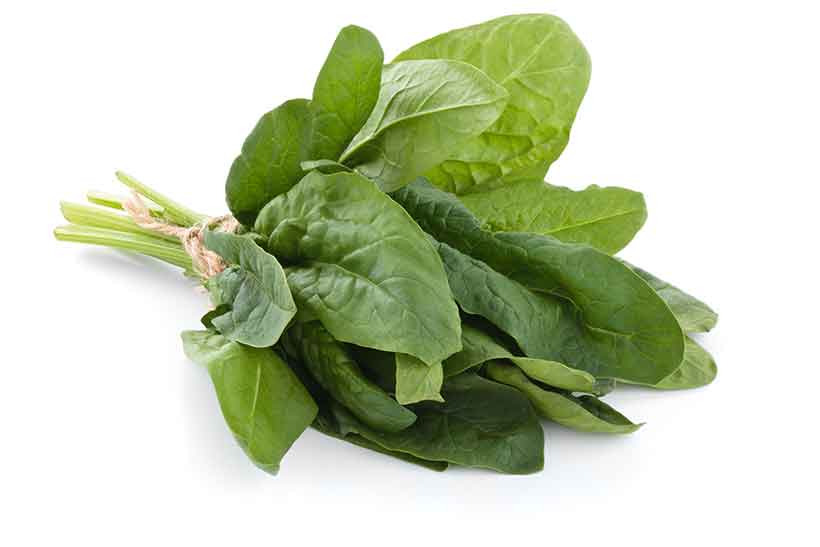
Spinach is among the most nutrient-dense of this list of vegetables.
It is a leafy green that is native to Asia, and it is incredibly high in vitamin A (as beta-carotene) and vitamins C and K1.
Spinach has an impressive nutrient profile too, and it provides a decent amount of almost every micronutrient ( 62 );
- Calories: 23 kcal
- Carbohydrate: 3.6 g
- Sugar: 0.4g
- Protein: 2.9 g
- Vitamin K: 604% RDA
- Vitamin A: 188% RDA
- Folate: 49% RDA
- Vitamin C: 47% RDA
- Manganese: 45% RDA
52. Sweet Potatoes
Their purple relative from Japan may be healthier, but regular sweet potatoes are one of the most popular veggies.
They have a soft and slightly sweet taste, especially when caramelized.
You can do a lot of things with this tuber, and sweet potatoes work well on their own or in soups, stews, and other dishes.
Their standout nutrient is vitamin A/beta-carotene ( 63 );
- Calories: 86 kcal
- Carbohydrate: 20.1 g
- Fiber: 3.0 g
- Vitamin A: 284% RDA
- Copper: 8% RDA
For a complete guide to sweet potatoes, see the following article:
Sweet Potatoes 101: Nutrition Facts and Health Benefits
Interestingly, the leaves of sweet potatoes are also edible, and they are a popular vegetable in some countries.
For more information on sweet potato leaves, see below:
5 Benefits of Sweet Potato Leaves (and Nutrition Facts)
53. Swiss Chard

Swiss chard is a nutritious leafy green that is a frequent staple in the Mediterranean region.
Typically, chard is used in raw salads but sauteing it tastes good too, and removes some of the bitter flavor.
Swiss chard’s edible leaves are green with a reddish tinge, and they contain a wealth of nutrients ( 64 );
- Calories: 19 kcal
- Sugar: 1.1g
- Vitamin K1: 1038% RDA
- Vitamin A: 122% RDA
- Magnesium: 20% RDA
- Manganese: 18% RDA
54. Tomatillo
The tomatillo belongs to the nightshade family of plants alongside tomatoes, eggplants and bell peppers.
With the alternate name of ‘Mexican husk tomato’, tomatillos are a staple in Mexican cuisine.
In terms of appearance, they a little similar to a large green tomato.
Tomatillos are the main ingredient in various central American sauces as well as green salsas.
Nutritionally, tomatillos are a good provider of vitamin C ( 65 );
- Calories: 32 kcal
- Fiber: 1.9 g
- Fat: 1.0 g
- Vitamin K1: 13% RDA
- Vitamin B3 : 9% RDA
- Potassium: 8% RDA
55. Tomatoes

Tomatoes are juicy, sweet, and slightly sour fruit.
Yes, fruit; botanically speaking tomatoes are fruit.
However, when was the last time you saw a tomato in a fruit salad? While technically tomatoes are a fruit, we use them as a vegetable in cooking.
They’re also a crucial culinary ingredient and a key feature of world cuisine, from Italian to Indian food.
They’re also good for our health and contain the carotenoid lycopene. Although further research is necessary, studies suggest this compound may potentially have anti-cancer and cardioprotective benefits ( 66 ).
Interestingly, lycopene is more available in processed tomato products than whole tomatoes.
Nutritionally speaking, tomatoes provide a good amount of beta-carotene and vitamin C ( 67 );
- Calories: 18 kcal
- Carbohydrate: 3.9 g
- Fiber: 1.2 g
- Sugar: 2.6g
- Vitamin C: 21% RDA
- Vitamin A: 17% RDA
- Vitamin K1 : 10% RDA
56. Turnips
Turnips are a root vegetable that grows in temperate regions around the world.
Turnips are often eaten on their own, either mashed, boiled or stewed. However, they work well in a range of dishes too.
The edible part of this root vegetable is a white bulb that provides a range of nutrients ( 68 );
- Calories: 28 kcal
- Carbohydrate: 6.4 g
- Sugar: 3.8g
- Manganese: 7% RDA
- Potassium : 5% RDA
57. Watercress

You wouldn’t guess so from looking at it, but watercress is one of the most nutritious vegetables out there.
Watercress is native to Europe and Asia, and it grows in areas surrounding slow-moving water such as lakes and ponds.
We can often find watercress in salads and soups, and the leaves add a lot of flavor.
This leafy vegetable has a kind of peppery taste, and it’s refreshing due to its high (95%) water content.
Surprisingly, 100g of watercress provides only 11 calories, and yet it’s still one of the most nutrient-rich vegetables ( 69 );
- Calories: 11 kcal
- Carbohydrate: 1.3 g
- Sugar: 0.2g
- Protein: 2.3 g
- Vitamin K: 312% RDA
- Vitamin C: 72% RDA
- Vitamin A : 64% RDA
- Calcium: 12% RDA
- Manganese: 12% RDA
58. Water Chestnut
- Calories: 97 kcal
- Carbohydrate: 23.9 g
- Potassium: 17% RDA
- Manganese: 17% RDA
- Copper : 16% RDA
- Vitamin B6: 16% RDA
- Vitamin B2: 12% RDA
Despite the name including “nut”, water chestnuts are a type of aquatic vegetable.
Especially popular in Chinese cuisine, the water chestnut has grown in popularity around the world.
While you can easily find these in canned form, they don’t taste anywhere near as flavorful as fresh water chestnuts. However, the fresh ones should be available at your local Chinese grocery store.
Water chestnuts are quite starchy, and therefore they’re higher in carbohydrate than most vegetables.
Concerning their nutrient profile, they’re a good source of potassium, copper, and Manganese ( 70 ).
See this full nutritional guide to water chestnuts for more information.
59. Zucchini (Courgette)

Here is another vegetable that has alternate names across the Atlantic.
Known by the original Italian word ‘zucchini’ in the US and Australia, this vegetable goes by the French name of ‘courgette’ in the UK, Ireland and New Zealand.
But whatever you call it, it still looks and tastes the same.
Zucchini can be enjoyed both raw or cooked, and you can even make vegetable noodles (dubbed “zoodles”) with it.
Zucchini has a fresh, soft and sweet flavor and texture, and it provides a good amount of nutrition too ( 71 );
- Calories: 16 kcal
- Carbohydrate: 3.3 g
- Fiber: 1.1 g
- Vitamin B6: 11% RDA
- Manganese : 9% RDA
- Folate: 7% RD
Final Thoughts
No matter which vegetable people prefer, all options can help to improve the overall dietary pattern. Vegetables tend to offer high amounts of essential nutrients for very few calories, and they can help to ensure essential vitamin and mineral requirements are met.
But there is no need to include any specific individual vegetable, and it is probably better to just focus on the ones that you enjoy the most.
To learn about some differences between raw and cooked vegetables, see this guide here .
Also, learn about the key nutritional differences between fresh and frozen produce .
13 thoughts on “59 Different Types of Vegetables (and Their Nutrition Profiles)”
it really help me in completing my project. thnxxxx🙂🙂🙂
No problem, Sandeep. Glad it helped you!
Thanks for this. I am a vegetable lover, just as well with all they have to offer….
Me too! Thanks for commenting.
Where did you get the information from ? Excellent job thanks!
No problem! You can click the little numbers in parentheses (1) for all the references/data sources.
Does anyone know where I can find these facts listed exactly like this in a book? Want to give as a present. Would love to have an A-Z list of veggies with their nutritional facts. Thank you!!!
Very helpful since I have diabetes.
Green Peas?
Good suggestion! I will add them in.
This presentation is so helpful. Many thanks Michael. I have been vegetarian for six years, mainly for health and longevity. I have been planning to work out all the nutrients that I am eating. I stumbled upon this article that has been so informative, adding to my knowledge of how the body functions and the best way to assist it.
French beans? Are chick peas, haricot, kidney beans classed as vegetables?
Thank you for your comments. Although those beans are sometimes classed as vegetables in their immature (green) state, they’re more commonly categorized as legumes.
If it helps, you can find the different types of legumes here: https://www.nutritionadvance.com/types-of-legumes/
Leave a Comment Cancel reply
Receive our nutrition updates.
Receive notification each time we publish a new article, and get exclusive guides direct to your inbox.
Receive a notification each time we publish a new article, and get exclusive guides direct to your inbox.
- Skip to main content
- Skip to secondary menu
- Skip to primary sidebar
- Skip to footer
Study Today
Largest Compilation of Structured Essays and Exams
Essay on Vegetables for Children & Students
December 16, 2017 by Study Mentor Leave a Comment
Vegetables constitute a major part of our diet. There are some parts of the plant which are consumed by humans for their daily nutrition. The definition of vegetable is still unclear.
This is because it is defined by the culture and tradition which flows down the generations. When we talk about the vegetables we normally do not include the category of fruits, cereals, nuts, and pulses.
The origin of vegetable is still a matter of fascination. The primal man hunted animals and gathered fruits to sustain his hunger needs. But by some miracle a vegetable seed was sown due to the forces of nature. And when the humans noticed it they came to know that they could also cultivate the land for production of fruits and vegetables.
According to the evidences, the cultivation of vegetables started from 1000 BC to 7000 BC. And is when agriculture started developing. As time passed trade grew.

At this point of time, China is the largest producer of vegetables. China exports a large no. of vegetables to other countries. India is the second largest producer in vegetables but it doesn’t export a large no. of vegetables because the vegetables produced are consumed within the country itself.
Vegetables are a very important constituent of our diet. Without vegetables no meal is complete. Vegetables can be cooked to provide a nutrition full meal. It can be eaten with breads like naan, roti, puri, and bedmi. It can also be eaten with rice.
Some vegetables can be consumed raw, in a salad while some need to be cooked before consumption. Vegetables grow on different parts of trees. For e.g. Onion, reddish and carrot grow in the roots of plants and vegetables like spinach are the leaves of a plant. The cauliflower is obtained from the flower of a tree. Vegetables like gourd, bitter gourd are grown on grapevine like structures.
Thus we see that we have a lot of variety in vegetables. We should concentrate on the consuming portions of vegetables. This provides the body adequate nutrients for its functioning since different vegetables provide the body with different kinds of vitamins and minerals.
Also consumption is a must especially for children who are in their growing stage. Parents should make sure that the children consume a nutrient rich diet and less of junk food. This will make their body strong and will help in the development of their brains and bodies.
Also vegetables increase the immunity of children towards countering diseases. At an early age, they are especially vulnerable to diseases. But the right amount of nutrition helps to fight diseases.
The advantages of consuming vegetables are many. First of all, vegetables help in weight management. Vegetables like potato and cauliflower can help you to gain weight. While vegetables like spinach and green vegetables can help immensely in weight reduction.
From time immemorial, our elders have promoted the consumption of green vegetables. This is because of the fact that green vegetables have a lot of iron in it. They help in the development of bones and muscles. It is actually good for us to consume vegetables at regular intervals so as to protect our body from any diseases.
Vegetables can help your body to fight against some particular type of cancers. Also a healthy intake of vegetables helps to burn the layers of fat in our body this ultimately improves the blood flow and helps in managing the blood pressure of a person. Consumption of vegetables also keeps cholesterol in check.

Also eating vegetables increases your life span by keeping you healthy, in general. Also their frequent intake ensures that we stay rejuvenated throughout the day and we don’t experience any drowsiness or nausea. Vegetables are the fuel to your well-being just like petrol is a fuel to a car.
Vegetables also contains a lot of fibers. Fiber is not a nutrient itself but it helps in the digestive system in our body. To lead a healthy life, one needs to make sure to intake the correct amount of iron or else, the consequences afterwards will be worse. Iron helps the body immensely in carrying out the daily chores.
Also anemia that means lack of hemoglobin in blood can also be cured through the right intake of vegetables. Nevertheless green vegetables also contain folic acid which works wonders on the health of pregnant women.
Make sure to consume healthy and nutritious food which keeps you fit as a fiddle and satiates your body and soul in every way possible, in every way you have ever wanted. Life is short and every moment of it should be made worth living. What is a life without health? Nothing.
As we say, Health is wealth . You cannot enjoy moments in your life without maintaining a healthy lifestyle. And to maintain a healthy lifestyle, you should consume vegetables. Even in old days of your life, you will have a healthy and disease free life, thanking the temptations of junk food you did not give into.
No we should also remember one thing. Vegetables are comparatively cheaper to non vegetarian sources of proteins. Although some trainers do recommend non-vegetarian food but doctors and dieticians worldwide have stuck on a unanimous opinion.
Reader Interactions
Leave a reply cancel reply.
Your email address will not be published. Required fields are marked *
Top Trending Essays in March 2021
- Essay on Pollution
- Essay on my School
- Summer Season
- My favourite teacher
- World heritage day quotes
- my family speech
- importance of trees essay
- autobiography of a pen
- honesty is the best policy essay
- essay on building a great india
- my favourite book essay
- essay on caa
- my favourite player
- autobiography of a river
- farewell speech for class 10 by class 9
- essay my favourite teacher 200 words
- internet influence on kids essay
- my favourite cartoon character
Brilliantly
Content & links.
Verified by Sur.ly
Essay for Students
- Essay for Class 1 to 5 Students
Scholarships for Students
- Class 1 Students Scholarship
- Class 2 Students Scholarship
- Class 3 Students Scholarship
- Class 4 Students Scholarship
- Class 5 students Scholarship
- Class 6 Students Scholarship
- Class 7 students Scholarship
- Class 8 Students Scholarship
- Class 9 Students Scholarship
- Class 10 Students Scholarship
- Class 11 Students Scholarship
- Class 12 Students Scholarship
STAY CONNECTED
- About Study Today
- Privacy Policy
- Terms & Conditions
Scholarships
- Apj Abdul Kalam Scholarship
- Ashirwad Scholarship
- Bihar Scholarship
- Canara Bank Scholarship
- Colgate Scholarship
- Dr Ambedkar Scholarship
- E District Scholarship
- Epass Karnataka Scholarship
- Fair And Lovely Scholarship
- Floridas John Mckay Scholarship
- Inspire Scholarship
- Jio Scholarship
- Karnataka Minority Scholarship
- Lic Scholarship
- Maulana Azad Scholarship
- Medhavi Scholarship
- Minority Scholarship
- Moma Scholarship
- Mp Scholarship
- Muslim Minority Scholarship
- Nsp Scholarship
- Oasis Scholarship
- Obc Scholarship
- Odisha Scholarship
- Pfms Scholarship
- Post Matric Scholarship
- Pre Matric Scholarship
- Prerana Scholarship
- Prime Minister Scholarship
- Rajasthan Scholarship
- Santoor Scholarship
- Sitaram Jindal Scholarship
- Ssp Scholarship
- Swami Vivekananda Scholarship
- Ts Epass Scholarship
- Up Scholarship
- Vidhyasaarathi Scholarship
- Wbmdfc Scholarship
- West Bengal Minority Scholarship
- Click Here Now!!
Mobile Number
Have you Burn Crackers this Diwali ? Yes No
Vegetables and Fruits
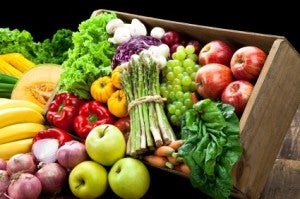
- Vegetables and fruits are an important part of a healthy diet, and variety is as important as quantity.
- No single fruit or vegetable provides all of the nutrients you need to be healthy. Eat plenty every day.
A diet rich in vegetables and fruits can lower blood pressure, reduce the risk of heart disease and stroke, prevent some types of cancer, lower risk of eye and digestive problems, and have a positive effect upon blood sugar, which can help keep appetite in check. Eating non-starchy vegetables and fruits like apples, pears, and green leafy vegetables may even promote weight loss. [1] Their low glycemic loads prevent blood sugar spikes that can increase hunger.
At least nine different families of fruits and vegetables exist, each with potentially hundreds of different plant compounds that are beneficial to health. Eat a variety of types and colors of produce in order to give your body the mix of nutrients it needs. This not only ensures a greater diversity of beneficial plant chemicals but also creates eye-appealing meals.

Tips to eat more vegetables and fruits each day
- Keep fruit where you can see it . Place several ready-to-eat washed whole fruits in a bowl or store chopped colorful fruits in a glass bowl in the refrigerator to tempt a sweet tooth.
- Explore the produce aisle and choose something new . Variety and color are key to a healthy diet. On most days, try to get at least one serving from each of the following categories: dark green leafy vegetables; yellow or orange fruits and vegetables; red fruits and vegetables; legumes (beans) and peas; and citrus fruits.
- Skip the potatoes . Choose other vegetables that are packed with different nutrients and more slowly digested carbohydrates .
- Make it a meal . Try cooking new recipes that include more vegetables. Salads, soups, and stir-fries are just a few ideas for increasing the number of tasty vegetables in your meals.

5 common questions about fruits and vegetables.
Vegetables, fruits, and disease, cardiovascular disease.
There is compelling evidence that a diet rich in fruits and vegetables can lower the risk of heart disease and stroke.
- A meta-analysis of cohort studies following 469,551 participants found that a higher intake of fruits and vegetables is associated with a reduced risk of death from cardiovascular disease, with an average reduction in risk of 4% for each additional serving per day of fruit and vegetables. [2]
- The largest and longest study to date, done as part of the Harvard-based Nurses’ Health Study and Health Professionals Follow-up Study, included almost 110,000 men and women whose health and dietary habits were followed for 14 years.
- The higher the average daily intake of fruits and vegetables, the lower the chances of developing cardiovascular disease. Compared with those in the lowest category of fruit and vegetable intake (less than 1.5 servings a day), those who averaged 8 or more servings a day were 30% less likely to have had a heart attack or stroke. [3]
- Although all fruits and vegetables likely contributed to this benefit, green leafy vegetables, such as lettuce, spinach, Swiss chard, and mustard greens, were most strongly associated with decreased risk of cardiovascular disease. Cruciferous vegetables such as broccoli, cauliflower, cabbage, Brussels sprouts , bok choy, and kale ; and citrus fruits such as oranges, lemons, limes, and grapefruit (and their juices) also made important contributions. [3]
- When researchers combined findings from the Harvard studies with several other long-term studies in the U.S. and Europe, and looked at coronary heart disease and stroke separately, they found a similar protective effect: Individuals who ate more than 5 servings of fruits and vegetables per day had roughly a 20% lower risk of coronary heart disease [4] and stroke, [5] compared with individuals who ate less than 3 servings per day.
Blood pressure
- The Dietary Approaches to Stop Hypertension (DASH) study [6] examined the effect on blood pressure of a diet that was rich in fruits, vegetables, and low-fat dairy products and that restricted the amount of saturated and total fat. The researchers found that people with high blood pressure who followed this diet reduced their systolic blood pressure (the upper number of a blood pressure reading) by about 11 mm Hg and their diastolic blood pressure (the lower number) by almost 6 mm Hg—as much as medications can achieve.
- A randomized trial known as the Optimal Macronutrient Intake Trial for Heart Health (OmniHeart) showed that this fruit and vegetable-rich diet lowered blood pressure even more when some of the carbohydrate was replaced with healthy unsaturated fat or protein. [7]
- In 2014 a meta-analysis of clinical trials and observational studies found that consumption of a vegetarian diet was associated with lower blood pressure. [8]
Numerous early studies revealed what appeared to be a strong link between eating fruits and vegetables and protection against cancer . Unlike case-control studies, cohort studies , which follow large groups of initially healthy individuals for years, generally provide more reliable information than case-control studies because they don’t rely on information from the past. And, in general, data from cohort studies have not consistently shown that a diet rich in fruits and vegetables prevents cancer.
- For example, over a 14-year period in the Nurses’ Health Study and the Health Professionals Follow-up Study, men and women with the highest intake of fruits and vegetables (8+ servings a day) were just as likely to have developed cancer as those who ate the fewest daily servings (under 1.5). [3]
- A meta-analysis of cohort studies found that a higher fruit and vegetable intake did not decrease the risk of deaths from cancer. [2]
A more likely possibility is that some types of fruits and vegetables may protect against certain cancers.
- A study by Farvid and colleagues followed a Nurses’ Health Study II cohort of 90,476 premenopausal women for 22 years and found that those who ate the most fruit during adolescence (about 3 servings a day) compared with those who ate the lowest intakes (0.5 servings a day) had a 25% lower risk of developing breast cancer. There was a significant reduction in breast cancer in women who had eaten higher intakes of apples, bananas , grapes, and corn during adolescence, and oranges and kale during early adulthood. No protection was found from drinking fruit juices at younger ages. [9]
- Farvid and colleagues followed 90, 534 premenopausal women from the Nurses’ Health Study II over 20 years and found that higher fiber intakes during adolescence and early adulthood were associated with a reduced risk of breast cancer later in life. When comparing the highest and lowest fiber intakes from fruits and vegetables, women with the highest fruit fiber intake had a 12% reduced risk of breast cancer; those with the highest vegetable fiber intake had an 11% reduced risk. [10]
- After following 182,145 women in the Nurses’ Health Study I and II for 30 years, Farvid’s team also found that women who ate more than 5.5 servings of fruits and vegetables each day (especially cruciferous and yellow/orange vegetables) had an 11% lower risk of breast cancer than those who ate 2.5 or fewer servings. Vegetable intake was strongly associated with a 15% lower risk of estrogen-receptor-negative tumors for every two additional servings of vegetables eaten daily. A higher intake of fruits and vegetables was associated with a lower risk of other aggressive tumors including HER2-enriched and basal-like tumors. [11]
- A report by the World Cancer Research Fund and the American Institute for Cancer Research suggests that non-starchy vegetables—such as lettuce and other leafy greens, broccoli, bok choy, cabbage, as well as garlic, onions, and the like—and fruits “probably” protect against several types of cancers, including those of the mouth, throat, voice box, esophagus, and stomach. Fruit probably also protects against lung cancer. [12]
Specific components of fruits and vegetables may also be protective against cancer. For example:
- A line of research stemming from a finding from the Health Professionals Follow-up Study suggests that tomatoes may help protect men against prostate cancer, especially aggressive forms of it. [12] One of the pigments that give tomatoes their red hue—lycopene—could be involved in this protective effect. Although several studies other than the Health Professionals Study have also demonstrated a link between tomatoes or lycopene and prostate cancer, others have not or have found only a weak connection. [14]
- Taken as a whole, however, these studies suggest that increased consumption of tomato-based products (especially cooked tomato products) and other lycopene-containing foods may reduce the occurrence of prostate cancer. [12] Lycopene is one of several carotenoids (compounds that the body can turn into vitamin A) found in brightly colored fruits and vegetables, and research suggests that foods containing carotenoids may protect against lung, mouth, and throat cancer. [12] But more research is needed to understand the exact relationship between fruits and vegetables, carotenoids, and cancer.
Some research looks specifically at whether individual fruits are associated with risk of type 2 diabetes. While there isn’t an abundance of research into this area yet, preliminary results are compelling.
- A study of over 66,000 women in the Nurses’ Health Study, 85,104 women from the Nurses’ Health Study II, and 36,173 men from the Health Professionals Follow-up Study—who were free of major chronic diseases—found that greater consumption of whole fruits—especially blueberries, grapes, and apples—was associated with a lower risk of type 2 diabetes. Another important finding was that greater consumption of fruit juice was associated with a higher risk of type 2 diabetes. [15]
- Additionally a study of over 70,000 female nurses aged 38-63 years, who were free of cardiovascular disease, cancer, and diabetes, showed that consumption of green leafy vegetables and fruit was associated with a lower risk of diabetes. While not conclusive, research also indicated that consumption of fruit juices may be associated with an increased risk among women. (16)
- A study of over 2,300 Finnish men showed that vegetables and fruits, especially berries, may reduce the risk of type 2 diabetes. [17]
Data from the Nurses’ Health Studies and the Health Professional’s Follow-up Study show that women and men who increased their intakes of fruits and vegetables over a 24-year period were more likely to have lost weight than those who ate the same amount or those who decreased their intake. Berries, apples, pears, soy, and cauliflower were associated with weight loss while starchier vegetables like potatoes, corn, and peas were linked with weight gain. [1] However, keep in mind that adding more produce into the diet won’t necessarily help with weight loss unless it replaces another food, such as refined carbohydrates of white bread and crackers.
Gastrointestinal health
Fruits and vegetables contain indigestible fiber, which absorbs water and expands as it passes through the digestive system. This can calm symptoms of an irritable bowel and, by triggering regular bowel movements, can relieve or prevent constipation. [18] The bulking and softening action of insoluble fiber also decreases pressure inside the intestinal tract and may help prevent diverticulosis. [19]
Eating fruits and vegetables can also keep your eyes healthy, and may help prevent two common aging-related eye diseases—cataracts and macular degeneration—which afflict millions of Americans over age 65. [20-23] Lutein and zeaxanthin, in particular, seem to reduce risk of cataracts. [24]
- Bertoia ML, Mukamal KJ, Cahill LE, Hou T, Ludwig DS, Mozaffarian D, Willett WC, Hu FB, Rimm EB. Changes in intake of fruits and vegetables and weight change in United States men and women followed for up to 24 years: analysis from three prospective cohort studies. PLoS medicine . 2015 Sep 22;12(9):e1001878.
- Wang X, Ouyang Y, Liu J, Zhu M, Zhao G, Bao W, Hu FB. Fruit and vegetable consumption and mortality from all causes, cardiovascular disease, and cancer: systematic review and dose-response meta-analysis of prospective cohort studies. BMJ . 2014 Jul 29;349:g4490.
- Hung HC, Joshipura KJ, Jiang R, Hu FB, Hunter D, Smith-Warner SA, Colditz GA, Rosner B, Spiegelman D, Willett WC. Fruit and vegetable intake and risk of major chronic disease. Journal of the National Cancer Institute . 2004 Nov 3;96(21):1577-84.
- He FJ, Nowson CA, Lucas M, MacGregor GA. Increased consumption of fruit and vegetables is related to a reduced risk of coronary heart disease: meta-analysis of cohort studies. Journal of human hypertension . 2007 Sep;21(9):717.
- He FJ, Nowson CA, MacGregor GA. Fruit and vegetable consumption and stroke: meta-analysis of cohort studies. The Lancet . 2006 Jan 28;367(9507):320-6.
- Appel LJ, Moore TJ, Obarzanek E, Vollmer WM, Svetkey LP, Sacks FM, Bray GA, Vogt TM, Cutler JA, Windhauser MM, Lin PH. A clinical trial of the effects of dietary patterns on blood pressure. New England Journal of Medicine . 1997 Apr 17;336(16):1117-24.
- Appel LJ, Sacks FM, Carey VJ, Obarzanek E, Swain JF, Miller ER, Conlin PR, Erlinger TP, Rosner BA, Laranjo NM, Charleston J. Effects of protein, monounsaturated fat, and carbohydrate intake on blood pressure and serum lipids: results of the OmniHeart randomized trial. JAMA . 2005 Nov 16;294(19):2455-64.
- Yokoyama Y, Nishimura K, Barnard ND, Takegami M, Watanabe M, Sekikawa A, Okamura T, Miyamoto Y. Vegetarian diets and blood pressure: a meta-analysis. JAMA internal medicine. 2014 Apr 1;174(4):577-87.
- Farvid MS, Chen WY, Michels KB, Cho E, Willett WC, Eliassen AH. Fruit and vegetable consumption in adolescence and early adulthood and risk of breast cancer: population based cohort study. BMJ . 2016 May 11;353:i2343.
- Farvid MS, Eliassen AH, Cho E, Liao X, Chen WY, Willett WC. Dietary fiber intake in young adults and breast cancer risk. Pediatrics . 2016 Mar 1;137(3):e20151226.
- Farvid MS, Chen WY, Rosner BA, Tamimi RM, Willett WC, Eliassen AH. Fruit and vegetable consumption and breast cancer incidence: Repeated measures over 30 years of follow‐up. International journal of cancer . 2018 Jul 6.
- Wiseman M. The Second World Cancer Research Fund/American Institute for Cancer Research Expert Report. Food, Nutrition, Physical Activity, and the Prevention of Cancer: A Global Perspective: Nutrition Society and BAPEN Medical Symposium on ‘Nutrition support in cancer therapy’. Proceedings of the Nutrition Society . 2008 Aug;67(3):253-6.
- Giovannucci E, Liu Y, Platz EA, Stampfer MJ, Willett WC. Risk factors for prostate cancer incidence and progression in the health professionals follow‐up study. International journal of cancer . 2007 Oct 1;121(7):1571-8.
- Kavanaugh CJ, Trumbo PR, Ellwood KC. The US Food and Drug Administration’s evidence-based review for qualified health claims: tomatoes, lycopene, and cancer. Journal of the National Cancer Institute . 2007 Jul 18;99(14):1074-85.
- Muraki I, Imamura F, Manson JE, Hu FB, Willett WC, van Dam RM, Sun Q. Fruit consumption and risk of type 2 diabetes: results from three prospective longitudinal cohort studies. BMJ . 2013 Aug 29;347:f5001.
- Bazzano LA, Li TY, Joshipura KJ, Hu FB. Intake of fruit, vegetables, and fruit juices and risk of diabetes in women. Diabetes Care . 2008 Apr 3.
- Mursu J, Virtanen JK, Tuomainen TP, Nurmi T, Voutilainen S. Intake of fruit, berries, and vegetables and risk of type 2 diabetes in Finnish men: the Kuopio Ischaemic Heart Disease Risk Factor Study–. The American journal of clinical nutrition . 2013 Nov 20;99(2):328-33.
- Lembo A, Camilleri M. Chronic constipation. New England Journal of Medicine . 2003 Oct 2;349(14):1360-8.
- Aldoori WH, Giovannucci EL, Rockett HR, Sampson L, Rimm EB, Willett AW. A prospective study of dietary fiber types and symptomatic diverticular disease in men. The Journal of nutrition . 1998 Oct 1;128(4):714-9.
- Brown L, Rimm EB, Seddon JM, Giovannucci EL, Chasan-Taber L, Spiegelman D, Willett WC, Hankinson SE. A prospective study of carotenoid intake and risk of cataract extraction in US men–. The American journal of clinical nutrition . 1999 Oct 1;70(4):517-24.
- Christen WG, Liu S, Schaumberg DA, Buring JE. Fruit and vegetable intake and the risk of cataract in women–. The American journal of clinical nutrition . 2005 Jun 1;81(6):1417-22.
- Moeller SM, Taylor A, Tucker KL, McCullough ML, Chylack Jr LT, Hankinson SE, Willett WC, Jacques PF. Overall adherence to the dietary guidelines for Americans is associated with reduced prevalence of early age-related nuclear lens opacities in women. The Journal of nutrition . 2004 Jul 1;134(7):1812-9.
- Cho E, Seddon JM, Rosner B, Willett WC, Hankinson SE. Prospective study of intake of fruits, vegetables, vitamins, and carotenoidsand risk of age-related maculopathy. Archives of Ophthalmology . 2004 Jun 1;122(6):883-92.
- Christen WG, Liu S, Glynn RJ, Gaziano JM, Buring JE. Dietary carotenoids, vitamins C and E, and risk of cataract in women: a prospective study. Archives of Ophthalmology . 2008 Jan 1;126(1):102-9.
Terms of Use
The contents of this website are for educational purposes and are not intended to offer personal medical advice. You should seek the advice of your physician or other qualified health provider with any questions you may have regarding a medical condition. Never disregard professional medical advice or delay in seeking it because of something you have read on this website. The Nutrition Source does not recommend or endorse any products.

IMAGES
VIDEO
COMMENTS
Vegetables are low in calories and fats but contain good amounts of vitamins and minerals. They are packed with vitamins A, K, B6, and C, and minerals like potassium, calcium, and iron. These nutrients help in maintaining optimal health. For instance, vitamin A is essential for good eyesight, while vitamin C boosts the immune system.
Essay on Vegetables for Class 1,2,3. Vegetables are a crucial part of our daily lives and they play a vital role in keeping us healthy. They provide us with essential nutrients, vitamins, and minerals that help our bodies function properly. In this essay, we will learn about the different types of vegetables and their importance in our diet.
There are a number of types of beans that are delicious to eat. Some of the most popular bean varieties include kidney beans, pinto beans, cannellini beans, soybean, chickpeas ( garbanzo beans ), and black beans. A cup of cooked kidney beans contains an impressive 15 g of protein (31% RDI) and only 225 calories.
Vegetables are usually classified on the basis of the part of the plant that is used for food. The root vegetables include beets, carrots, radishes, sweet potatoes, and turnips. Stem vegetables include asparagus and kohlrabi. Among the edible tubers, or underground stems, are potatoes. The leaf and leafstalk vegetables include brussels sprouts ...
Vitamin A: 47% RDA. Vitamin C: 25% RDA. Folate: 24% RDA. Calcium: 16% RDA. Key Point: Arugula leaves supply a decent source of vitamin A and K1, and they are very low in calories and carbohydrate. 3. Asparagus. Out of all the different vegetables in the world, asparagus has a good argument for being the tastiest.
After a certain time, harmful bacteria may grow on them and increase the risk of foodborne illness. Essay # 4. Storage Care for Vegetables: Proper post-harvest storage aimed at extending and ensuring shelf life is best effected by efficient cold chain application. All vegetables benefit from proper post-harvest care.
First of all, vegetables help in weight management. Vegetables like potato and cauliflower can help you to gain weight. While vegetables like spinach and green vegetables can help immensely in weight reduction. From time immemorial, our elders have promoted the consumption of green vegetables.
A diet rich in vegetables and fruits can lower blood pressure, reduce the risk of heart disease and stroke, prevent some types of cancer, lower risk of eye and digestive problems, and have a positive effect upon blood sugar, which can help keep appetite in check. Eating non-starchy vegetables and fruits like apples, pears, and green leafy ...